

PROFIT PICTURE
FEBRUARY






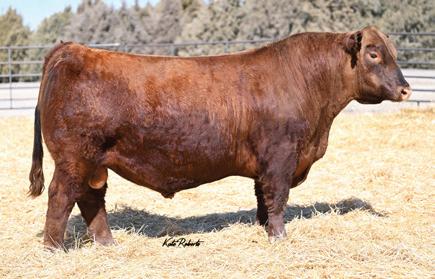




• Largest supplier of Gelbvieh & Balancer genetics (100+ AI sires).
• Unlimited supply of top Angus and Red Angus AI sires for your Balancer needs.
• FREE shipping and handling on orders of 60 or more units
• Unparalleled customer service.
• Commercial Producers: Majority of our sires are available to you at substantially discounted commercial prices.
• Complete listing of Cattlemen’s Connection AI sires, their stats, DNA, pedigree and EPDs is available online: www.cattlemensconnection.com
• All Cattlemen’s Connection AI Sires are tested FREE for all known Genetic Defects.





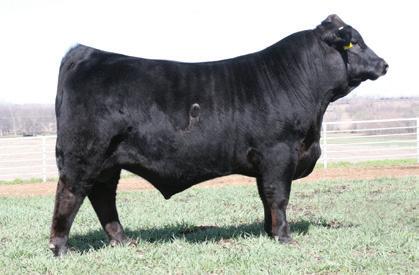


Laura Handke by Laura Handke by Laura Handke by Laura Handke
by AGA Staff
by Laura Handke


FACTS ABOUT AGA
AGA HALL OF FAME
AGA BREEDER OF THE
2024 COMMERCIAL PRODUCER OF THE YEAR
OF DIRECTORS MEETING HIGHLIGHTS AMERICAN GELBVIEH ASSOCIATION ELECTS BOARD OF DIRECOTRS
CHAMPIONS AWARDED IN AGA STEER CHALLENGE
Sign up to receive your free subscription to The Profit Picture by subscribing online or completing this form and mailing to American Gelbvieh Association, Attn: Profit Picture, 1001 S. 70th St., Suite 215, Lincoln, NE 68510. Comments and feedback welcome to info@gelbvieh.org or 303-465-2333.
NAME:
ADDRESS: CITY, STATE, ZIP: Subscribe online at www.gelbvieh.org/news/publications/profit-picture/





ASSOCIATION STAFF
HAROLD BERTZ EXECUTIVE DIRECTOR haroldb@gelbvieh.org
TOM STRAHM
COMMERCIAL MARKETING DIRECTOR tom@gelbvieh.org
WESS ANGLIN
COMMERCIAL MARKETING SPECIALIST wess@gelbvieh.org
MORGAN HAUGER COMMUNICATIONS COORDINATOR morgan@gelbvieh.org
MALERIE MARKLEY GELBVIEH MEDIA PRODUCTIONS COORDINATOR malerie@gelbvieh.org
TAWNIE DEJONG, M.S. MEMBER & YOUTH ACTIVITIES COORDINATOR tawnie@gelbvieh.org
SARAH MUMM PERFORMANCE PROGRAMS COORDINATOR sarah@gelbvieh.org
WAYDE PICKINPAUGH, M.S. DNA SERVICES COORDINATOR wayde@gelbvieh.org
MARGO MCKENDREE OFFICE OPERATIONS COORDINATOR margo@gelbvieh.org
SHIANNA OCKEN REGISTRY COORDINATOR shianna@gelbvieh.org
CAMILLE HENNERBERG REGISTRY/DNA SERVICES SPECIALIST camille@gelbvieh.org
DAN WARNER, PRESIDENT BEAVER CITY, NEB.• 308.962.6511 dan@warnerbeef.com
STUART JARVIS, VICE PRESIDENT PHILLIPSBURG, KAN. • 785.543.8120 bararrow@ruraltel.net
TOM VEHIGE, TREASURER BILLINGS, MO. • 417.444.2268 tbarscattle@hotmail.com
BRENT OVERMILLER, SECRETARY SMITH CENTER, KAN. • 785.282.0485 brento4532@hotmail.com
DIRECTORS
GREG “BUBBA” ANDERSON
MARION, N.C. • 828.442.6869 grega1983@live.com
DAVID LARSON CLEARBROOK, MINN. • 218.766.3323 david.larson.lrl@gmail.com
ZACK BUTLER MILTON, TENN. • 615.308.8628 butlercreek1952@aol.com
MARK COVINGTON MONTROSE, COLO. • 970.209.1956 covinginc@hotmail.com
JOHN SHEARER CANTON, KAN. • 620.654.6507 circle_s@hometelco.net
TROY FORBES
DE SMET, S.D. • 605.530.4764 forbes_gelbvieh@hotmail.com
This issue of the Profit Picture finds breeders amid final preparations for their annual bull sales and commercial cattlemen digesting the information into informed decisions as to which herd sires will propel their programs into the next several replacement generations. It is an exciting, though sometimes exhausting, time of year.
At the American Gelbvieh Association Annual Convention, a panel of experts answered questions and shared wisdom with attendees during the Cattlemen’s Profit Roundup. One of the quotes that really struck home with me was to buy bulls that will be valuable despite the movement of the cattle cycle. We are fortunate to be in the price upside of the current cycle, but we all realize that a downtrend in prices will occur at some time. Buying genetics now that will improve your herd, allowing you to capture value when the market turns is a logical decision. How do we do that?
Your seedstock provider spends a lot of time, effort and money giving you the most accurate and up to date information available. Beyond birth, weaning and yearling weights, ultrasound data and scrotal measurements, many bulls sell with genomically enhanced or GE-EPDs. These EPDs rely not only on actual phenotypic measurements and pedigree history but DNA differences as well. This added information can increase the accuracy of the bull’s EPDs and lead to more reliability in the outcome of a
SALE SEASON
FROM THE CORNER OFFICE BY HAROLD BERTZ
young bull – it is equivalent to buying a bull that has sired one to two calf crops. This added layer of predictability can move your herd forward with greater speed and better results.
We all work diligently to select bulls that build on our herd’s strengths while improving weaknesses. To achieve maximum results, it is important to know what the weaknesses are in our cow herds. One way to determine this is to do an EPD average for the sires represented in your cow herd and your current bull battery. The AGA marketing team will assist you with this analysis of the Gelbvieh and Balancer® portion of your bull battery. Utilizing this information to strategically match the EPDs of your next sire purchase to enhance and improve traits can design calves that will improve your replacements and increase the value of your feeder calves.
Beyond the assistance in purchasing the bulls that best fit your program, the marketing team would welcome the opportunity to assist you as you market calves at your chosen marketing venue. The Feeder Finder is a simple, effective and FREE tool for ranchers to alert cattle buyers across the country to the details about Gelbvieh and Balancerinfluenced cattle you are selling. A simple, online sign-up with information about when and where your cattle will sell along with details about your vaccination protocol and genetics can promote your cattle to a wide audience.
In fact, over 17,000-head were promoted by AGA Marketing staff last year!
Another opportunity for commercial cattlemen to add value to their calves is through the Balancer Edge program. Working with IMI Global, producers can enroll in an age, source and genetic verification program that assures buyers the integrity of an age range, one ranch location and minimum thresholds of Gelbvieh genetics in their calves. Enrollment is simple and can be done over the phone. You will need dates of first and last calf born and pedigrees of sires to verify Gelbvieh genetics. Join the winning teams at Gelbvieh and IMI Global in representing the extra work you have put into your calf crop.
Contact Tom Strahm, tom@gelbvieh.org or Wess Anglin, wess@gelbvieh.org for more information on the Feeder Finder and Balancer Edge programs.
The entire staff at the American Gelbvieh Association is committed to serving our purebred producers while offering extended services to the commercial producers that use Gelbvieh and Balancer genetics. We welcome inquiries and hope to assist you in developing a game plan to propel your herd forward and market your calves in the most advantageous way. I encourage you to utilize the experts we have assembled at AGA.
Happy bull selection and I look forward to seeing you down the road.

Harold Bertz is the executive director of the American Gelbvieh Association and began his role in 2024. Bertz recently served as the chief operating officer of the American Royal in Kansas City. He previously worked for the Red Angus Association of America for nearly 10 years focusing on growing the acceptance of Red Angus cattle with commercial cow/calf producers and feedyards. The Bertz family farm near Mayview has been in the family for seven generations. He and his wife, Melisa, are also involved with her family’s farm near Parker, Kansas. They have two grown children that are active in the beef industry.


A NEW YEAR, A NEW PRESIDENT
When the lights dimmed on the 54th annual National AGA Convention, Dan Warner had been elected president to serve and help guide the association through 2025.
We had a chance to catch up with Warner to learn more about his family’s operation, his involvement and promotion of the Gelbvieh and Balancer® breed and what is on his to-do list for 2025.
Located in Arapahoe, Nebraska, Warner Beef Genetics began registering their first cattle in 1991 – an FFA project that got into his blood, Dan’s passion for high-quality, fertile cattle that added value to their operation led him to AGA. By 1995, the operation was selling highquality bulls private treaty and offered their first sale at the ranch in 2001.
Today, Warner Beef Genetics is ran by Dan, his wife Katie, their children and Dan’s older brother, Darren and his wife, Amy. The ranch manages around 1,000 cows with 600 of those females registered with AGA.
Warner’s AGA leadership is longstanding. He served as the president of the AGJA in his youth and in multiple capacities on the junior board 19951998. His commitment to service continued on the AGA board where he
served for six years from 2008 to 2014 before being reelected to serve in 2024.
As the incoming president, he has a clear vision for the breed through 2025 and beyond: Growth!
“I want to continue to grow our breed in numbers,” he shares. “I believe there are cows out there that we all have that we aren’t keeping active, and I want to help get more cows active that we have on ranches across the U.S. and turn that data into added value for the breed.”
Warner believes that, as a breed, Gelbvieh and Balancer cattle are well positioned to drive herd rebuild with the attributes the industry is in need of. From his experience with the Maternal Merit Group, which sells around 600-commercially-bred heifers of multiple breeds, his prediction is a wider disparity between sale barn heifers and program-driven females. The differentiator will come down to service orientation, Warner says, in which the history of females is strongly promoted along with an operation’s culling process. He calls the documentation and history a risk mitigation tool for buyers that all seedstock producers should be emphasizing in their program.
“We can and will build a stronger market share if we continue to prove
the fact that Gelbvieh and Balancer females are more fertile and stay in the herd longer,” he says. “The reason we are in the Gelbvieh business is because they’re fertile. They take part of the work of running cows out of the spectrum because they are so fertile and settle so easily.”
Fertility, Warner believes, will be the leading driver the Gelbvieh and Balancer breed leverages to increase market share during the cow herd expansion. No breed offers both documented and word-of-mouth driven fertility success better than the Gelbvieh and Balancer breed.
“We can prove that producers can spend the same amount of money on heifers (as they would for another breed) and see a higher retention rate because those heifers settle on their first mating. It is money in a commercial or seedstock producer’s pocket,” he adds.
Look for Dan’s insights as he assumes the monthly “View from the Board” column in 2025 and continues to share his vision for the association and breed in 2025 and beyond.

Warner Beef Genetics is ran by Dan, his wife Katie, their children and Dan’s older brother, Darren and his wife, Amy. The ranch manages











FAST FACTS
WHO WE ARE
The American Gelbvieh Association (AGA) is dedicated to recording and promoting Gelbvieh, Balancer and Gelbvieh-influenced cattle, while providing members and their customers programs and services to advance the breed. The AGA consists of approximately 1,100 members with a registry database that contains over one million animals including approximately 40,000 currently active Gelbvieh, Balancer® and Gelbvieh-influenced cows.
THE STRENGTHS OF GELBVIEH
The Gelbvieh breed is well known throughout the industry for its maternal strengths and superior growth. With attributes such as more pounds of calf weaned, added fertility, greater cow herd longevity and heavier carcass weights, just to name a few, Gelbvieh and Balancer cattle offer genetics that work for the commercial cattle business.
With the high costs associated with the development or purchase of replacement females, sustained production in a herd is essential. Gelbvieh females are proven to stay in the herd longer.
U.S. Meat Animal Research Center (USMARC) data shows Gelbvieh females have the most moderate mature cow size of the seven major beef breeds. This reduced mature cow size allows for puberty to be reached at an earlier age, which leads to calving earlier in the season and producing a heavier calf at a younger age.
Gelbvieh and Balancer cattle excel in traits such as growth, stayability, and productivity. Using Gelbvieh and Balancer genetics in a crossbreeding program can help increase the profitability of an operation. See additional pounds and added profit through more


efficiency and greater longevity of cows as well as heavier, faster-gaining feeder cattle.
WHAT IS A BALANCER ® ?
Balancer cattle are registered hybrid seedstock that have documented pedigrees and expected progeny differences. The American Gelbvieh Association was the first beef cattle breed to recognize and include a hybrid animal as registered stock.
Balancer animals are 25% to 75% Gelbvieh with the balance of Angus or Red Angus. Balancer cattle combine the Gelbvieh growth, muscle, leanness, fertility, longevity and low yield grading ability with the carcass qualities of Angus.
Balancer cattle offer a simple and powerful way to maintain hybrid vigor and a profitable blend of British and Continental genetics without a complicated crossbreeding system. These cattle fit well into all aspects of the beef industry, including commercial cow/calf operations and on the rail.
HOW DO GELBVIEH AND BALANCER ® CROSSBRED FEMALES PERFORM BETTER?
It’s all in the heterosis, or hybrid vigor, described as the increase in performance of the crossbred animal compared to the average of the straight-bred parents. Heterosis impacts traits with low heritability, e.g., reproduction. Producers with crossbred cows can see a higher percentage of their cowherd breed back on the first cycle due to maternal heterosis.
INDIVIDUAL HETEROSIS
Individual heterosis is the improvement in performance by the individual crossbred animal above




the average of its parents. Increased calf livability, weaning weight, yearling weight and carcass traits are examples of individual heterosis in crossbred calves.
MATERNAL HETEROSIS
Maternal heterosis leads to the combined improvement in traits from the dam that cause increases in the performance of her and her progeny. Examples of maternal heterosis in a beef cow include younger age at puberty, increased calving rate, increased survival of her calf to weaning, longevity and pounds of calf produced in her lifetime.
LOOKING TO BUY BULLS THIS SPRING?
If you’re a producer looking to purchase new genetics for your herd this spring, use Gelbvieh.org as your goto resource for Gelbvieh and Balancer sale information. The upcoming events calendar can be found under the Marketing tab on the website. Also, don’t forget to check out the sale catalog page on the AGA website, also found under the marketing tab, to view upcoming sale catalogs.
FOCUS ON PROGRAMS FOR COMMERCIAL PRODUCERS
FEEDER FINDER
Feeder Finder is a free email service offered by the AGA to promote and assist in marketing load lots of Gelbvieh and Balancer-influenced feeder cattle. Producers who have cattle to sell are encouraged to fill out the online form or contact the AGA staff to submit information about their cattle.


BALANCER® EDGE
Balancer® Edge is a source and age verification program for feeder cattle sired by Gelbvieh and Balancer bulls. Offered by the AGA in partnership with IMI Global, this program gives producers the opportunity to participate in a breed-identified feeder calf marketing program with the option to customize. Balancer® Edge customers can choose additional value-added programs, which open the doors to additional markets and the opportunity to generate even more value for their feeder calves.
COMMERCIAL MARKETING STAFF
The American Gelbvieh Association has outstanding marketing staff that understands both the beef business and the Gelbvieh breed. They are available to help commercial cattlemen find Gelbvieh or Balancer genetics to fit your programs or assist in marketing Gelbvieh-influenced breeding animals or feeder cattle. To learn more about our commercial marketing services, contact Tom Strahm, AGA commercial marketing director, at 785-547-7999 or tom@gelbvieh. org or Wess Anglin, AGA commercial marketing specialist, at 662-292-4582 or wess@gelbvieh.org. MALERIE
FAST FACTS
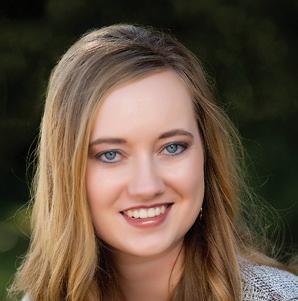



Gelbvieh
AGJA: MORE THAN A MEMBERSHIP
What can you buy for $30 in today’s economy?
If you have a young person, under the age of 21, in your life $30 a year can afford them a lifetime of memories, hands-on and interpersonal skills and a network of friendships that spans the country.
The American Gelbvieh Junior Association (AGJA) is a phenomenal organization that is about so much more than showing cattle.
A springboard for success, AGJA cultivates an environment that develops unified and educated leaders to become the best versions of themselves in the pursuits of their passions. Collectively, the association instills a sense of responsibility, dedication, pride and professionalism in members while creating a platform for the development of professional and interpersonal skills.
BY AGA STAFF
NO CATTLE, NO PROBLEM
We can all learn a thing or two in a group environment, surrounded by likeminded peers. Regardless of whether a young person chooses to show cattle, AGJA and the National AGJA Show has something for everyone:
Graphic Design
Video
Poster
Photography
Creative Writing
Ag Podcast
Prepared Speaking
Team Fitting
Judging Contest
Sales Talk
Quiz Bowl
Skill-a-Thon
Ambassador
…AND NETWORKING, SCHOLARSHIPS, NATIONAL RECOGNITION, the list goes on. There’s no six degrees of separation in agriculture, as we all know; the networking opportunities AGJA offers are unsurpassed.
SIGN ME UP!
Membership is open to youth who have not yet reached their 22nd birthday prior to January 1 of the calendar year of enrollment. Annual AGJA membership dues are only $30 and come with an annual subscription to Gelbvieh World magazine. Learn more by using the camera on your phone to scan the QR code below:









• Visit our informative website postrockcattle.com February 22, 2025 12:30 p.m. (CST) At the Ranch - Barnard, Kansas
• All bulls and females have genomically enhanced EPD’s and are sire verified and tested for Homo Black and Homo Polled
• 98% of the bulls selling are Homo Polled and 75% are Homo Black
• 92% of the bulls selling are by breed leading AI Sires
• All bulls have complete ultrasound data and performance information in large and meaningful contemporary groups
• Videos of the entire offering available online after February 1
• First Breeding Season and injury guarantee
• Selling every sound 6 year old female plus select fall and spring 2 year olds. Most of the females have a calf at side by sale day







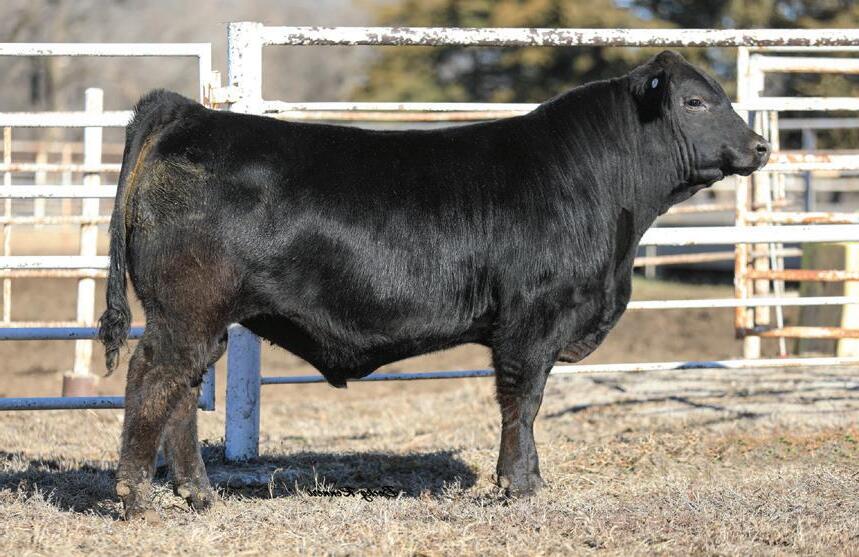

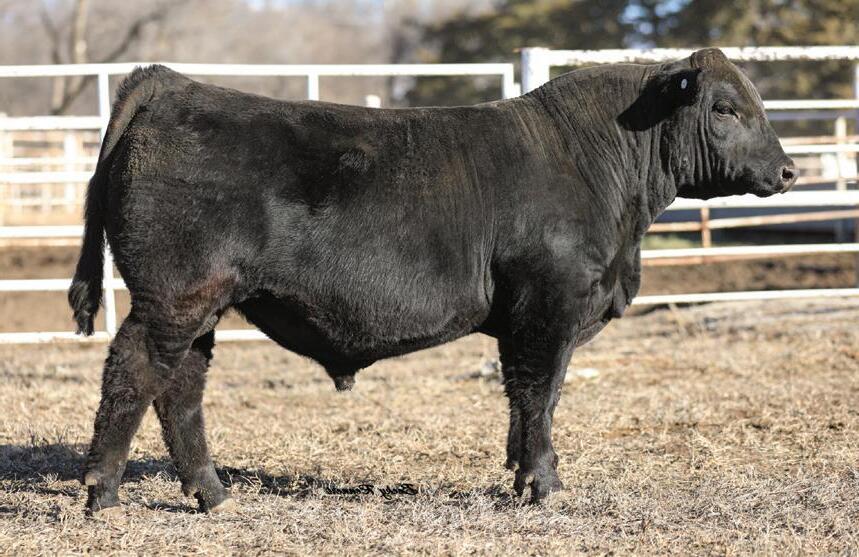





OVER THE FENCE WITH
John Fox, along with his partner Kim, operates Fox Farms in Cedar County, Missouri on land whose roots run deep. The homesteaded ground, that has been expanded over the years, is home to Fox’s cow-calf and backgrounding operation.
I got a chance to sit down with John to learn more about his operation and the goals he has for his herd. The answer is easy to summarize: To produce better cattle every year.
In the interview below, John shares insights into his operation, his journey with different breeds, the importance of genetics and what led him home to the Gelbvieh and Balancer™ breed.
Tom: John, tell us about your family’s history in cattle breeding and how you
FOX FARMS
BY TOM STRAHM
came to use Gelbvieh and Balancer genetics?
John: Our journey began with my father using Angus cattle. We then transitioned to Charolais crosses to improve growth and color uniformity. However, we noticed a decline in milk production, which led us to look at other breeds. We started using red Gelbvieh bulls on our Charolais cross cows through Seedstock Plus. This brought back the milk production we needed. When the demand for black cattle increased, we switched to black Balancers. Since then, we’ve been consistently improving our herd by selecting better bulls with each purchase.
Tom: What improvements have you seen in your herd since beginning to use Gelbvieh and Balancer bulls?
John: We’ve seen a lot of improvement in our herd, especially in milk production. We focus on bulls with a with a higher percentage of Gelbvieh to maintain milk production for raising a calf. It has really helped us to sell replacement heifers, a lot of times at a good premium. The feedback we get helps us to know that we’re moving in the right direction.
Tom: You mentioned that your current set of first-calf heifers might be the best you’ve ever raised. What makes them stand out?
John: These heifers have been exceptional in several ways. They started calving around September 10, and we’ve been impressed with their condition, disposition and milk production. They’re maintaining their condition well

even with calves at their side. My wife works a full-time job and a lot of the time I’m here by myself. I’ve been able to handle these heifers by myself and that makes a big difference.
Tom: Has the fertility of Gelbvieh and Balancer influenced cows and heifers lived up to your expectations?
John: The fertility rate has been very good. We have a good mineral program, too. Our cows have been breeding back at 90% for the past several years. The milk is also really good. It just keeps increasing. So those two things are really where I feel like the breed has benefitted us. We are going in the right direction with a Gelbvieh-cross.
Tom: How important are relationships in your operation, particularly when it comes to buying bulls?
John: Having a good relationship with the people you work and do business with is important. Whether it’s your veterinarian or the breeder, you can always gain information that helps you to provide a better product. That’s what we work to do here. Maintaining good relationships fits into the combination of using all of your resources to make a better product.
We’ve got a good reputation and have buyers who want to know when we are going to sell our feeder calves. To me, it’s a sign that we are going in the right direction. You know, even in times when there were so many cattle moving and the sale numbers were higher, we still had that demand for our cattle because the buyers knew how they would perform.
Tom: What do you look for when selecting bulls for your operation?
John: I look at the bull. I want to see what kind of cover he has, his shape – how he’s made. Beyond that,
I focus on several things. Calving ease is important, and I look for milk production of 20 plus. I also consider docility and overall conformation.
Tom: Do you feel like the Gelbvieh bulls you purchase last? How is the ROI?
John: We invest a lot in our bulls so we expect them to last at least four or five years, compared to what we see as the industry average of one or two years. We purchase insurance because of the substantial investment we’ve made but we rarely have to use it. Our bulls have performed well over the duration which I see as another positive aspect of the breed. The longevity of a Gelbvieh bull adds a lot of value to our operation.


Tom: What are your thoughts on bull purchases.
John: I think people need to up their ante on bull purchases. We shouldn’t just be looking at producing a calf, we should be looking at producing a quality calf and a good bull helps you get there.
Tom: What advice would you give to others in the livestock industry?
John: My main advice is to focus on producing quality calves, not just quantity. It’s important to invest in good genetics by purchasing quality bulls from reputable breeders who can guide you in the right direction. While it may seem expensive initially, it pays off in the long run. Consider how many calves a bull produces over its lifetime and the impact of keeping his daughters in your herd. Good genetics, combined with proper management and stockmanship, is a key to being successful in this industry.


























































Seedstock Plus Spring Sale Dates!
North Missouri Bull Sale
February 22, 2025
Kingsville Livestock, Kingsville, MO
Selling 125 BLACK Balancer & Gelbvieh Bulls! All 18 months old!
Arkansas Bull Sale
March 1, 2025
Hope Livestock, Hope, AR
Selling 75 Angus, Brangus, Balancer & Gelbvieh Bulls! Red & Black!
2 yr olds & 18 months!
Red Reward Bull & Female Sale
March 8, 2025
Wheeler Livestock, Osceola, MO
Selling 50 RED Balancer & Gelbvieh Bulls & RED females! Registered & Commercial!
South Missouri Bull & Female Sale
March 22, 2025
Joplin Regional Stockyards, Carthage, MO
Selling 125 BLACK Balancer & Gelbvieh Bulls! 18 months & yearlings! Also BLACK females! Registered & Commercial!

• Guaranteed Sight-Unseen Purchases!
• Free Trucking on every bull! No fine print!
• The best disposition & soundness sort!
• Extensive Data & Genomic EPDs!
• All Bulls Are Semen & Trich Tested!
• Videos of sale bulls the week before the sale! www. dvauction.com or www.seedstockplus.com
THE : COMPARING FEED OPTIONS BEST BUY
“When we think about annual cow costs – really any kind of beef production – grazed and harvested feeds are our biggest cost category expense. If we add up everything between 40 and 70% of annual cow cost is feed.”
Aaron Berger, University of Nebraska – Lincoln, beef extension educator, told producers as he opened the third webinar in the Fundamentals of Feeding the Cow series in November. The session took an economical look at the true costs of feeding cattle and what the numbers, not just the ones with dollar signs in front of them, can tell a producer about their opportunity to be profitable.
Leading an apples-to-apples analysis, Berger told producers that in order to truly know feed costs, the price comparison must be calculated on a price per unit of energy or price per unit of protein into the belly of the cow. Additionally, feeding a cow must be looked at economically.
“Economically means no free land, no free labor, no free money. If you grow the grass and you own the land, we are still going to ask cows, on paper, to pay fair market value for the grass,” he explained.
FEATURE BY LAURA HANDKE

This approach ensures that all resources, including owned land and labor, are accounted for at fair market value.
In Nebraska, Berger shared, annual cow costs are estimated around $700 per cow, with grazing rates ranging from $45 to $100 per pair per month, depending on the region.
GRAZING VS. HARVESTED FEED
Traditionally, grazed forage has been less expensive than harvested or manufactured feed. However, recent market conditions have narrowed this gap in some areas.
“There are some situations where grazed feed and harvested feed are somewhat comparable at times in terms of their cost competitiveness,” Berger said.
When evaluating grazing costs, it’s crucial to consider expenses such as fencing, water development and checking cattle. For harvested feeds, the true cost goes beyond the purchase price and must include transportation, storage, and feeding expenses.
THE HIDDEN COSTS OF FEEDING
Berger shared a quote by Dave Pratt: “It’s not only the cost of the feed, it’s the cost of feeding.”
You don’t know what you don’t know and working to put a value on all expenses associated with getting feed into the belly of a cow allows you to create a finite amount of unknown expenses.
For example, when purchasing hay, producers must account for:
Transportation losses (2-3%)
Storage losses (5-10%)
Feeding losses (10-15%)
These losses can significantly increase the effective cost of the feed. In some cases, 20-25% of purchased hay may be lost before consumption, potentially turning $200/ton hay into $250/ton feed in the cow’s belly.
COMPARING FEED OPTIONS
To make informed decisions, producers should compare feeds based on their cost per unit of nutrients (protein and energy) delivered to the cow. The Feed Cost Calculator, a tool developed by UNL and demonstrated in the webinar, is a valuable resource in helping producers calculate true feeding value.
The Feed Cost Calculator allows users to input various feeds, their nutritional content, and associated costs to determine the most economical options.

Don’t forget to account for all of the costs, including transportation, Beef Extension Specialist, Troy Wall added.
“Make sure you put the miles in there (the Feed Cost Calculator). Some people will feed, put lick tubs out on cornstalks and that makes sense because they’re 60 or 80 miles from where the cornstalks are,” he said.
PROTEIN SUPPLEMENTATION AND COST REDUCTION
Strategic protein supplementation can be an effective way to reduce overall feed costs, especially when utilizing lowquality forages.
“If we supplement some protein on low quality forage, what happens is we provide some protein and sometimes a little bit of energy to those rumen microbes. They’re able to more effectively and efficiently utilize low quality forage,” Berger said.
Supplementing protein can increase the intake and utilization of lowquality forages, potentially reducing the need for more expensive feeds. Dried distillers grains (DDGs), for example, can be a cost-effective protein and energy source when transportation costs are manageable.
FEED TESTING AND ANALYSIS
How can a comparison be made if you don’t know the value of each feed, including the feed you’ve produced? Feed testing is parallel to profitability and a necessity that operations of all sizes should invest in. Not only does feed analysis ensure that you are getting the most out of every dollar spent, it also ensures you aren’t over or under feeding your cattle.
During the live Q&A session, a producer shared alfalfa hay samples that showed significant variations in both protein content and energy value. One sample had low TDN (Total Digestible Nutrients) despite having a high crude protein percentage. Without testing, those discrepancies would go unnoticed and impact animal performance and production costs.
Feed quality can vary significantly, even within the same type of feed harvested at different times. Testing allows producers to accurately formulate rations and compare feed options based on their true nutritional value. A feed analysis provides a comprehensive breakdown of nutrients that include crude protein, energy (TDN), fiber and mineral content that allows a producer to fine-tune their operations.
BALANCING RATIONS AND
MEETING NUTRITIONAL REQUIREMENTS
Understanding the nutritional requirements of cattle at different stages of production is crucial for cost-effective feeding.
All registered webinar attendees were provided a workbook with the slides and nutritional tables that were used throughout the three-part series. Wall encouraged producers to review the maintenance requirements at each stage of gestation as well as maintenance and formulate feed needs accordingly.
“If you’ve tested some of your feeds and you know you’re going to be feeding those feedstuffs, match them up to your cows. If you have a cow in the last third of gestation, look at her requirements table, see what the required TDN and crude protein is and then match your feeds,” Wall says.
Regardless of the resources you choose to use, the UNL team shared, it’s paramount to know what kind of nutritional punch your feed packs, how it matches the needs of your cow herd and what the true cost of that feed is. Feed testing and cost calculators can help balance animal performance with economic efficiency. And I believe we would all agree that understanding the full economic picture is the only path to a profitable operation we can hand down to the next generation.
ARKANSAS & IOWA BREEDERS

David & Rita Martin 256 Boyce Road Judsonia, AR 72081
C: 501.278.7614 www.martincattleco.com
Private Treaty Sales Available Year Round
COLORADO BREEDERS
Heather Scott (775) 790-3456
Brandon Scott (970) 589-5483
Parachute, CO 81635
STATE ROUNDUP
Neola, Iowa
Gelbvieh-Angus-Balancer
BLACK & POLLED PRIVATE TREATY SALES Breed-leading Performance from Quality Genetics Kevin Gunderson: Al Schulz: 402-510-8103 402-676-5292

Jim Roelle 38330 CR 49 Peetz, CO 80747 (C): 970-520-1224
jr.plateau@hotmail.com
www.plateaugelbvieh.com
Featuring Black, Polled Gelbvieh & Balancer® genetics with balanced trait selection. Next Bull Sale February 27, 2025. Livestock Exchange, LLC., Brush, CO.
MINNESOTA & MONTANA BREEDERS

“Gelbvieh since 1973”
Kathleen Rankin Jim Bjorkman 1285 Nine Mile Rd. 406-937-4815 Oilmont, MT 59466 krankin@northerntel.net 406-460-0535 www.kickinghorseranch.com
KathlEEn ranKin 406-937-4815 1285 ninE MilE rd. • oilMont, Mt 59466 krankin@northerntel.net www.kickinghorseranch.com Performance cattle for the real world.
NEBRASKA & SOUTH DAKOTA BREEDERS

402-879-4976 Cole Epley 402-621-0359 824 road 3000, supErior, nE 6897 mlm68978@yahoo.com www.gelbviehbulls.com
Rippe Gelbvieh
Duane & Brenda, Dustin & Karla Rippe 6775 ROAD D • HUBBELL, NE 68375 (H) 402-324-4176
Duane (C): 402-200-0096
Dustin (C): 316-323-4874
dustin.rippe@yahoo.com
www.rippegelbvieh.com
“To produce superior Gelbvieh and Balancer® seedstock based on economically important traits, which provide more profitability for our customers, and ensure the consumer a very satisfactory eating experience.”
Martens Gelbvieh Gary Martens 2126 500th St • Walnut, IA 51577 712.764.5007 (H) • 712.249.5744 (C) martensgl@yahoo.com Annual Bull and Female Sale March



Represent your state in the State Roundup section of the September and February Profit Pictures, and the July Herd Reference Edition of Gelbvieh World.
To purchase an ad space, contact Malerie Markley at malerie@gelbvieh.org or 303-465-2333.

DEVELOPING A YEAR ROUND FEEDING PLAN:
THE WHY & THE HOW
In part two of a three-part webinar series hosted by University of Nebraska – Lincoln, Beef Extension Specialists Aaron Berger, Erin Laborie and Troy Walz discussed the importance of developing a year-round feeding plan…the why and the how.
A comprehensive year-round plan, the team shared, can help mitigate the challenges faced from fluctuating feed costs to unpredictable weather patterns.
EVERY OPERATION NEEDS A YEAR-ROUND FEEDING PLAN
“Think about everything as a system,” UNL Beef Specialist Troy Walz told attendees. “Think about how if you change one thing, it will affect everything else you do.”
The holistic approach positions operations to better manage both herd health and expenses, both of which lead to improved profitability opportunities.
A year-round feeding plan is essential for cattle producers to ensure consistent nutrition for their herd while managing costs and resources effectively. By developing a comprehensive plan, ranchers can:
1. Anticipate nutritional needs throughout different production stages: Understanding how a cow’s nutritional needs change during pregnancy, lactation and maintenance is the first step in
FEATURE BY LAURA HANDKE
developing a year-round feeding strategy. This knowledge positions you to plan a feeding strategy for each stage of production.
“If we look at a 1200-pound cow, her dry matter intake is going to be about 24 pounds, with around 1.8 pounds of crude protein and 13 pounds of energy. So she needs a diet that’s 7.5% crude protein and 54% TDN. That same cow producing 25 pounds of milk goes up to 31.3 pounds of dry matter intake per day, 10.6% crude protein and 18 pounds of energy. If a cow is producing more milk, that will go up.” Walz says. “You have to know what your requirements are at each stage of production.”
2. Optimize the use of available resources: Are you making the most of the on- and off-farm resources that are available? An often-overlooked opportunity, crop residue should be a part of your feeding plan, if available. Consider factors like cost, nutritional value and seasonal availability.
3. Identify potential feed shortages in advance: By monitoring feed inventories, forage production, and weather forecasts, you can anticipate periods when feed may be scarce and plan accordingly, either by stockpiling feed or arranging alternative sources
4. Adjust strategies based on changing conditions: Cattle require flexibility and feeding them is no different. Being flexible and responsive
to factors like drought, market fluctuations, or unexpected changes in feed quality, allows modifications to feeding plans.
“Think about body condition scoring cows when they come home. If you’ve got a group that is extra thin, after weaning is a great time to put weight on them. Send those cows to stalks and think about supplementing them with distillers grains or some corn,” Berger says.
BETTER DROUGHT PREPAREDNESS AND MITIGATION
A well-designed feeding plan can be instrumental in helping to weather drought conditions. Diverse feed sources and grazing strategies will help to build resilience in an operation.
Laborie notes that a common mistake she sees producers make in drought situations is supplementing protein without adjusting feed sources.
“Supplementing protein on grass actually increases digestion, so she’s going to end up eating more grass and making our problem worse. If calves are still nursing, weaning would be a better option to reduce a cow’s requirements, then you can feed the calf separately,” she says. “If you’re supplementing protein because forage quality is lower, like in the fall of the year, that may be necessary, just keep in mind that they are going to eat more.”


Keeping a drought scenario top of mind for each growing season can help mitigate an otherwise costly feed and water situation.
1. Stockpiling forages: Think about designating pastures for fall and winter grazing to stretch your hay stockpile.
2. Incorporating drought-tolerant plant species: Native grasses and legumes are a great addition to pastures. Not only do legumes add nitrogen to the system that will improve grass growth, but they also hold water in the soil profile that grasses can benefit from during drought conditions.
3. Developing water resources: No feeding plan is complete without water. Spend some time thinking about water resources and how they can be improved. With higher calf
prices, it may be an opportune time to consider installing automatic waterers in some owned pastures or visiting with landlords about cost sharing water infrastructure improvements on rented acres.
CONTROL THE CONTROLLABLES
Economics should be a part of every decision made on the ranch. And since feeding costs range between 40 to 70% of total operating costs, knowing when and where you can and should save and spend is important. If it isn’t profitable, ultimately it isn’t sustainable.
When you think about the economics of feeding, there are many factors that should be considered beyond the cost per ton of feed. The answer is a question:
Above, we mentioned the increasing nutritional requirements of a
1200-pound cow producing 25 pounds of milk during peak lactation. What is the average size of the cows in your herd? Do you know how much milk your cows are producing at peak lactation – most of us don’t. What is the TDN, crude protein and energy composition of the feedstuffs you have access to? Do you have a way of finding out and will your feed supplier provide that information? Do you test your hay? What kind of forages do you have access to and could 10 pounds of red clover seed per acre make a difference for your grazing opportunities and drought resilience?
No two operations are the same. What makes sense for yours, and how can controlling the controllables improve your operation’s long-term success?












2024 AGA NATIONAL CONVENTION


AMERICAN GELBVIEH ASSOCIATION ELECTS BOARD OF DIRECTORS
Members of the American Gelbvieh Association (AGA) elected five candidates to the board of directors as the annual meeting held December 6, 2024, during the AGA National Convention in Kansas City, Missouri.
Newly and re-elected board members are Zack Butler, Milton, Tenn.; Gregg Hartman, Pueblo, Colo.; Stuart Jarvis, Phillipsburg, Kan.; John Shearer, Canton, Kan.; and Mark Stock, Waukon, Iowa.
The AGA board of directors also elected individuals to serve in leadership positions on the executive committee for 2025. Dan Warner, Beaver City, Neb. was elected president. Stuart Jarvis, Phillipsburg, Kan. was elected vice president. Brent Overmiller, Smith Center, Kan. was elected to serve a second term as secretary, and Tom Vehige, Billings, Mo. was elected treasurer.
Other members of the board include: Greg Anderson, Marion, N.C.; Mark
Covington, Montrose, Colo.; Troy Forbes, De Smet, S.D.; Justin Taubenheim, Amherst, Neb.; Cory Voss, Bruning, Neb.; William McIntosh, Georgetown, Ky.; David Larson, Clearbrook, Minn.
Retiring members of the 2024 AGA board of directors were Lori Maude and Todd Bickett who both wrapped up a two-term tenure and Gary Felger, who retired after one term.F
The American Gelbvieh Association elected directors and officers for 2025 during its national convention in Kansas City, Mo. Back row (left to right): Gregg Hartman, Pueblo, Colo., Greg Anderson, Marion, N.C., Mark Stock, Waukon, Iowa, David Larson, Clearbrook, Minn., John Shearer, Canton, Kan., Zack Butler, Milton, Tenn., Troy Forbes, De Smet, S.D., Justin Taubenheim, Amherst, Neb., William McIntosh, Georgetown, Ky., Mark
Covington, Montrose, Colo. Front row (left to right): Dan Warner, Beaver City, Neb., Stuart Jarvis, Phillipsburg, Kan., Brent Overmiller, Smith Center, Kan., Tom Vehige, Billings, Mo., Harold Bertz, Lincoln, Neb.
















































HALL OF FAME

Leon and Jan Dunn of Sandy Knoll Farm in St. John, Kansas, were inducted into the American Gelbvieh Association Hall of Fame at the 54th annual American Gelbvieh Association National Convention.
This honor recognizes the couple’s longtime dedication to the Gelbvieh and Balancer® breed and their significant contributions to the cattle industry over the past four decades. The Dunn’s journey began at Kansas State University, where they met through mutual friends. Married in 1965, they purchased an irrigated farm on their wedding day, laying the foundation for what would become a thriving cattle operation.
“We bought the farm and got married the same day, and both of them have been wonderful,” Leon shares with a smile.
Over the years, the Dunns have developed a diverse and innovative operation at Sandy Knoll Farm. Their enterprise includes a swine multiplier unit for a major company, a Gelbvieh cattle herd managed by their son Brian, alfalfa production, and irrigated crops.
2024 HALL OF FAME INDUCTEES: LEON AND JAN DUNN, SANDY KNOLL FARM
The Dunns have been pioneers in incorporating technology and data collection into their breeding program. Since 1995, they have collected carcass data, and since 2009, they have gathered feed efficiency data. They also conduct Residual Feed Intake (RFI) testing on bulls and use DNA testing and ultrasound data for every cow in their herd.
“We think it’s number one really important to have proper structure,” Leon shares. “We think health is very important. We’ve found that top genetics and good health, make for some really productive animals.”
As charter members of the Kansas Gelbvieh Association, Leon served as president while Jan held the position of secretary/treasurer for 10 years. In 1986, they founded the Kansas Junior Gelbvieh Association to support youth development in the breed.
“We think it’s important that the young people have a chance to explore the Gelbvieh breed and a lot of the contests that are offered,” both share.
To navigate the challenges of private treaty sales, the Dunns joined SeedStock
Plus in 2000, an operational decision Leon hails as a godsend.
Looking ahead, the Dunns remain optimistic about the future of the Gelbvieh breed.
“There’s a bright future for the Gelbvieh cattle as long as we stay on the cutting edge of the industry and not be afraid to endorse the technology coming down the pipe,” both concurred.
Leon and Jan’s induction into the AGA Hall of Fame is not only a recognition of their past achievements but also a testament to their ongoing influence in the industry – and influence we are all grateful for.
“We certainly appreciated everybody that helped us along the way,” both share of their recognition of the honor. “Thank you!”F


BREEDER OF THE YEAR

The American Gelbvieh Association (AGA) recognized 4T Gelbvieh as the 2024 Breeder of the Year during the National Convention in Kansas City, Missouri December 4-6.
The award highlights the dedication and achievements of Jeff and Connie Tabor, who have tirelessly championed the Gelbvieh breed since 2002.
Starting in Southeastern Kansas with a commercial Gelbvieh herd, 4T Gelbvieh transitioned to registered cattle and moved their operation to Agra, Oklahoma. Today, they manage nearly 100 head of cattle and retain 25% of weaned calves for direct-toconsumer beef sales. 4T’s finished beef business includes partnerships with local restaurants and marketing campaigns that emphasize the premium quality of Gelbvieh beef. Their efforts have even placed Gelbvieh beef on the tables of the Oklahoma Governor’s mansion.
The Tabors have made significant contributions to the breed. They won the National Western Grand Champion title in 2015 with both a Gelbvieh heifer and Balancer™ bull; 4T went on to sweep the Tulsa State Fair that same year. Extending beyond the show ring. Show cattle
4T GELBVIEH HONORED AS AGA BREEDER OF THE YEAR
operations for 4T have been overseen by KC Youngblood for many years –leadership both Jeff and Connie attribute to 4T’s success in some of the top shows in the country.
4T’s commitment and service to the Gelbvieh breed helped to initiate Oklahoma’s Gelbvieh Field Days and have been featured in Calf News.
Connie’s advocacy for beef education exemplifies 4T Gelbvieh’s thoughtleadership within the industry.
“We are very honored to even be considered for the award,” Connie shares. “There are so many deserving members in the Gelbvieh Association, and to be placed in this category is truly humbling.”
Connie is BQA certified, a Master of Beef Advocacy graduate, and has served as
president of the Oklahoma Cattlewomen. In 2024, Connie took on the role of Secretary for the American National Cattlewomen.
Jeff and Connie have also served as junior advisors for both Kansas and Oklahoma programs, mentoring the next generation of cattle producers.
Generations of the Tabor family, including their children and grandchildren, play active roles in the operation.
“It’s special to see three generations contributing to our ranch. The future of the Gelbvieh breed is in great hands,” Jeff says.
Join us in congratulating 4T Gelbvieh on their recognition as AGA’s 2024 Breeder of the Year.F















COMMERCIAL PRODUCER OF THE YEAR

THE SACCO BROTHERS: A LEGACY OF SUSTAINABLE RANCHING IN UTAH
The Sacco Brothers Land and Livestock operation stands as a testament to the power of family-run businesses and is the recipient of this year’s Commercial Producer of the Year award.
The Utah-based ranch, operated by four brothers and their wives – Rudy; Vic and his wife Frankie; Joe and his wife Billie; and Rex and his wife Debbie who has passed.
As members of the next generation Josh and Jen Westover are heavily involved in the ranch and were in attendance along with Vic, Frankie, Joe, and Billie Sacco to receive the award at the 54th annual American Gelbvieh Association National Convention in Kansas City, Missouri.
In addition to Josh and Jen, Sacco Brothers Land and Livestock is in good hands with the numerous nieces, nephews and grandkids who will serve as the future of the ranch.
The Sacco Brothers run a cow-calf operation that currently manages around 500 head of cattle. This number has been reduced from 700 due to a three-year drought, showcasing the ranch’s ability to adapt to challenging environmental conditions. Their vast operation spans an impressive 247,000 acres, combining both Bureau of Land Management (BLM) and private grounds.
One of the most remarkable aspects of the Sacco Brothers’ operation is their grazing strategy. Unlike many ranches, they don’t rely on hay feeding. Instead, they’ve
developed a sophisticated grazing system that utilizes their extensive rangeland, which stretches from spring and summer pastures at elevations up to 10,000 feet down to winter grazing areas.
BREED SELECTION AND GENETIC IMPROVEMENT
The Sacco Brothers have been pioneers in introducing the Gelbvieh breed to their part of Utah. Their herd consists almost exclusively of Gelbvieh and Balancer cattle, with a few Simmental-Angus crosses. This breed selection has proven highly successful, as evidenced by the outstanding performance of their calves in feedlots and at slaughter.
The ranch’s commitment to quality is reflected in their marketing strategy. For the past seven years, their calves have been purchased by the same buyer, Kent Nelson, who takes them to Nebraska for finishing. The calves have consistently achieved an impressive 98% choice grade or better, a testament to the Sacco Brothers’ breeding program and management practices.
The Sacco Brothers utilize feedlot and carcass data on all calves sold, allowing them to make informed decisions when selecting bulls for breeding. This datadriven approach ensures continuous improvement in their herd genetics, focusing on traits that enhance feed efficiency and carcass quality.
LEADERSHIP
The Sacco Brothers take their role as land stewards seriously. They have implemented various range improvement projects, including the construction of ponds and the management of drainage systems. These efforts not only benefit their cattle but also support wildlife populations, demonstrating their commitment to environmental sustainability.
By relying on responsible grazing practices and avoiding intensive farming methods, the Sacco Brothers maintain a remarkably small carbon footprint. This approach aligns with growing consumer demand for sustainably produced beef.
The Sacco family’s influence extends beyond their ranch. Rex Sacco has held leadership positions in several industry organizations, including serving as the first chairman of the National Cattle Beef Association Public Lands Council and as president of the Eastern Utah Cattleman’s Association. The family continues to be actively involved in these organizations, contributing to the broader cattle industry’s development. From their modest start with just 19 cows in 1986 to their current status as respected industry leaders, the Sacco Brothers have demonstrated that sustainable, efficient cattle production is not only possible but also profitable. Their success story serves as an inspiration to ranchers across the country, proving that with dedication, innovation, and respect for the land, the American ranching tradition can thrive in the modern era.F






• 500 Mile Free Delivery
•
• Disposition Guarantee
• Soundness Guarantee
• Volume Discounts






Stockyard
Whitewater








2024 AGA NATIONAL CONVENTION

BOARD OF DIRECTORS MEETING
HIGHLIGHTS
The 54th annual American Gelbvieh Association National Convention serves as the sounding board for change and improvement within the breed. Each year, the board and membership convene to discuss the changes that help to move our breed forward.
At the 2024 meeting in Kansas City, Mo., the following amendments were discussed:
1. The board moved to accept the Rules and Bylaws committee recommendation to reduce the number of board directors from 15 to 11. The limit of three board of directors per state will remain. The change will not be ratified until the 2025 Annual Convention when it will be presented to the membership and voted on.
2. The board moved to accept the clarification changes from the Rules and Bylaws committee as presented:
a. Accept the recommendation not add the following to Rule 2.B.D.
AI Sires: “Can be requested by the original applicant of registration or the current owner.”
b. Accept the recommendation for Rule 2.C.2 Donor Dam Requirements to read as: “Donor Dam Permit on file with AGA. This permit is required for progeny of Donor Dams to be registered. A Donor Dam Permit may be requested by the original applicant of registration or the current owner and obtained from the AGA upon application.
(The change allows the original owner to request an AI Sire Permit or a Donor Dam Permit in addition to the transferred
owner. Previously, only the current owner could request the permits.)
3. The board moved to take 66% of unrealized gains each year (from July to July) to use towards marketing for the following fiscal year. The money is generated through investments and will be applied to AGA marketing efforts to further the breed and brand recognition of the Gelbvieh and Balancer® breed.
If you haven’t been to an AGA annual convention, you’re missing the opportunity to weigh in on the propositions that help to shape the future of the Gelbvieh breed. We invite all of our members to join the conversation and make your voices heard throughout the coming year and at the 55th Annual American Gelbvieh Association National Convention in 2025. F


Gelbvieh/Balancer® Show
1:00 PM ET, Friday, February 28, 2025
Gelbvieh/Balancer® Sale
11:30 AM ET, Saturday, March 1, 2025
Junior Heifer & Steer Show
8:00 AM ET, Sunday, March 2, 2025


2024 Kentucky Beef Expo Champions






2024 Grand Champion Balancer Female PMFG She’s A Lady 304L exhibited by Pleasant Meadows Farm
2024 Grand Champion Gelbvieh Female PADO Ms. Rebel 222K exhibited by Padon Farms
2024 Grand Champion Pen Show Female DMLF Lady Antebellum Lady exhibited by Dustin and Marlee Lanham Farms


Judd Ranch 47th Gelbvieh, Balancer®
Judd Ranch 47th Gelbvieh,
at the ranch, Pomona, Kansas • Saturday, March
at the ranch, Pomona, Kansas • Saturday, March



Judd Ranch has been honored as the #1 Dam of Merit Cowherd in the Gelbvieh Breed for 21 of the past 27 years, 1998–2024!
100% of the Gelbvieh & Balancer sale bulls feature Judd Ranch honored Dam of Merit Genetics. Maternal Cow Power behind every sale bull.
Average Daily Gain of fall yearling bulls: 4.17 lbs/day! 230 black polled bulls sell. 291 homozygous polled bulls sell


83 lb. average birth weight: 901 lb. actual weaning weight average on the sale bulls.
100 purebred Gelbvieh, 201 Balancer® & 4 purebred Red Angus bulls sell.
35 of the 40 top selling bulls in the 2024 sale sold to commercial producers. Catalog online!


Don’t miss Judd Ranch on The American Rancher!
Judd Ranch will be featured on The American Rancher Monday, February 10 at 8:00 PM central time. The episode will also air again at midnight February 10 and Sunday, February 16 at 11:00 AM on RFD-TV (Dish 231 & DirecTV 345)
Set your DVR’s! You won’t want to miss the Judd Ranch premier on RFD-TV the week of February 10!
1, at 12:00 noon • 1 hour
1, at 12:00 noon • 1 hour southwest of
Plus Gelbvieh, Balancer® & Red Angus Bulls Sell
• 195 17-19 month old Bulls
• 110 12-14 month old Bulls
99% Sired by Breed Leading AI Sires
230 Black Polled Bulls
291 Homozygous Polled Bulls
All sale bulls are Judd Ranch born and raised.
Quality Acceptance Guarantee on all Sight Unseen purchases
Free Trucking in U.S. on purchases of $20,000 +
Trucking is very affordable because Judd Ranch bulls annually sell into 20+ states
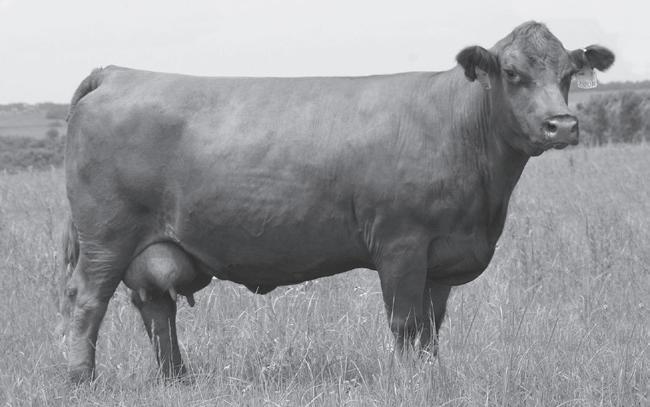


Judd Ranch Gelbvieh Maternal Strength
Judd Ranch Red Angus Maternal Strength
CHAMPIONS AWARDED IN NINTH
ANNUAL AMERICAN GELBVIEH FOUNDATION SCALE AND RAIL CONTEST AND STEER CHALLENGE
The results are in, and champions have been awarded from the 2024 American Gelbvieh Foundation (AGF) Scale and Rail Contest and Steer Challenge. The contest harvested 103 head from 13 participants, awarding a total of $3250.00 in cash prizes and 20 banners sponsored by the AGF.
The steers had an excellent overall performance with an average daily gain of 3.72pounds per head per day and a dry matter feed conversion of 6.62:1.0. The AGF extends a special thank you to Kinsley Feeders of Kinsley, Kansas, and Derek Martin, for hosting and supporting the contest.
BY TOM STRAHM
The steers were harvested at National Beef in Dodge City, Kansas, and sold on the USPB grid. Thank you to Stuart Jarvis for donating the USPB delivery rights.
The steers had an overall hot carcass weight of 941 pounds with 96% having a yield grade 1, 2, or 3.
The AGF continues to help advance the Gelbvieh breed through its support of research and development. For this reason, the AGF continues its Scale and Rail Contest and Steer Challenge. These two projects provide the information and funds necessary to generate data sets to advance Gelbvieh carcass merit. Together, these projects will solidify
carcass merit within the Gelbvieh breed and place the cattle in a more competitive position in the beef industry through providing supplementary carcass data on Gelbvieh-influenced genetics. In addition to the data collected and the knowledge gained from these projects, money raised will help to further develop more accurate tools for ranchers when selecting Gelbvieh and Balancer® genetics.
SCALE & RAIL CONTEST
RESULTS
The Scale and Rail Contest award $1,250 in cash prizes and 14 banners to outstanding participants in both the Gelbvieh and Balancer divisions.

Award winners left to right: Blake Hojer, Hojer Ranch; David Larson, Larson’s Lost River Livestock; Kyle Cavalli, Post Rock Cattle Company; Leland Clark, Post Rock Cattle Company.

CHAMPION AVERAGE DAILY
GAIN GELBVIEH STEER
Tag: L20
Average Daily Gain: 4.85
Owned By: Larson’s Lost River Livestock
Sired By: Chevelle J112
CHAMPION AVERAGE DAILY GAIN BALANCER STEER
Tag: 113L8
Average Daily Gain: 5.25
Owned By: Post Rock Cattle Company
Sired By: Post Rock Top Gun65F8 ET
CHAMPION CARCASS VALUE GELBVIEH STEER
Tag: L20
Carcass Value: $3321.45
Owned By: Larson’s Lost River Livestock
Sired By: Chevelle J112
CHAMPION CARCASS VALUE BALANCER STEER
Tag: 344
Carcass Value: $3453.79
Owned By: Raile Cattle Company
Sired By: Enterprise E080
CHAMPION PEN OF BALANCER STEERS
Pen Value: $9,328.43
Owned By: Raile Cattle Company
Sired By: Esquire 254G230 ET
RESERVE CHAMPION PEN OF BALANCER STEERS
Pen Value: $9,222.83
Owned By: Post Rock Cattle Company
Sired By: Go Time 781J
STEER CHALLENGE RESULTS
Participants of the 2024 Steer Challenge were awarded $2,000 in cash prizes and 6 banners. All six participants, Boehler Gelbvieh, Raile Cattle Company, Post Rock Cattle Company, Flying H
Genetics, Larson’s Lost River Ranch and Wilkinson Gelbvieh Ranch, each donated $1000.00 to the AGF. Thank you for your continued support!
CHAMPION AVERAGE DAILY GAIN
Tag: L20
Average Daily Gain: 4.85
Sired By: Chevelle J112
CHAMPION CARCASS STEER
Tag: 344
Carcass Value: $3453.79
Owned By: Raile Cattle Company
Sired By: Enterprise E080
Congratulations to all the 2024 Scale and Rail Contest and Steer Challenge champions and thank you to everyone who participated in the contest. To view complete results and learn more about the contest, visit https://gelbvieh.org/ foundation/projects.
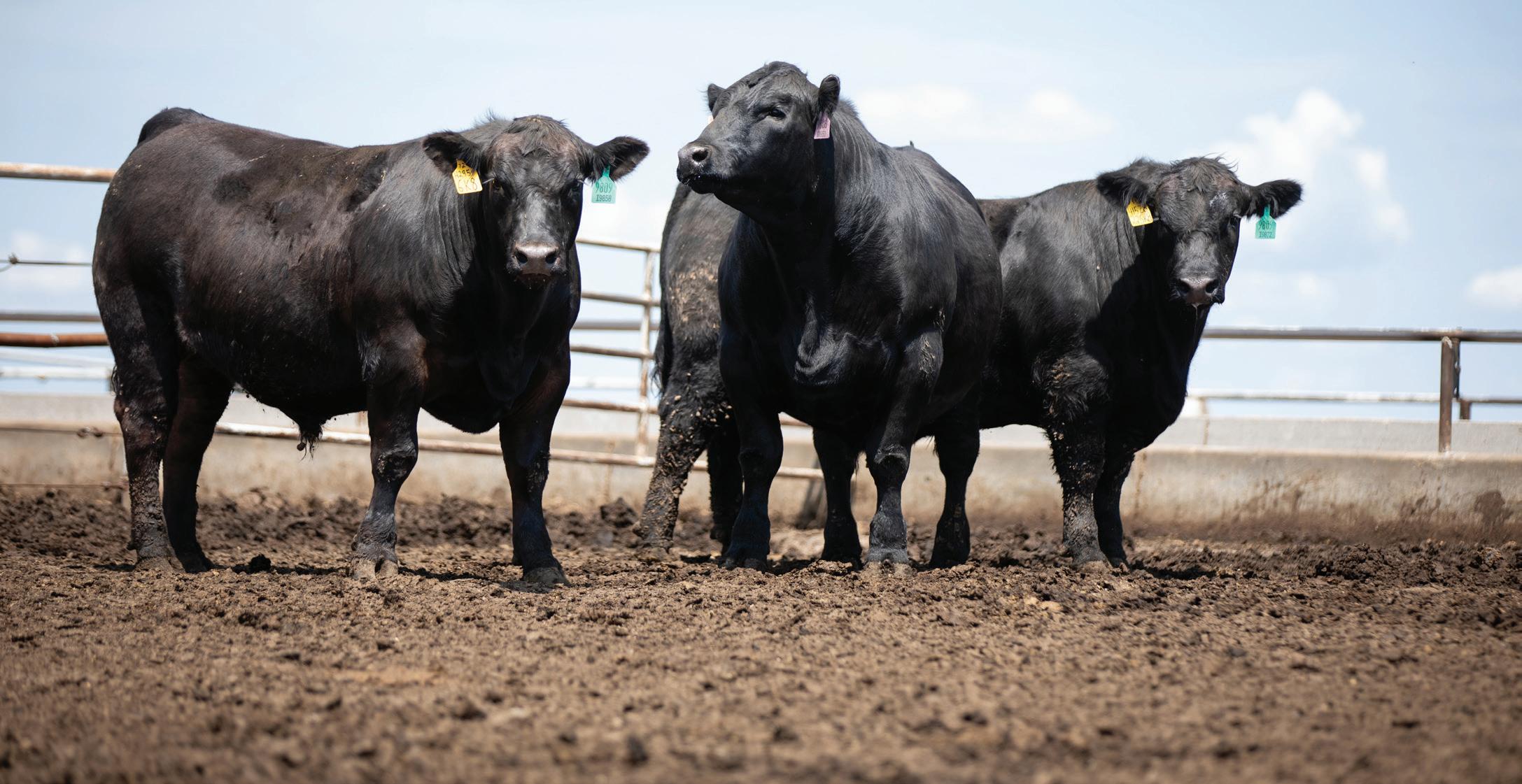


RIPPE GELBVIEH
[ Using data to increase your profits

“Information is the oil of the 21st century, and analytics is the combustion engine.” - Peter Sondergaard
“What gets measured, gets managed.”
- Peter Drucker
Go where the DATA is:
For Females:
• Track Udder Scores
• Measure Cow Size
• Measure Cow Efficiency through percentage body weight weaned
Avg. Birth Weight 78
Avg. Weaning Weight 699
95% are Homozygous Polled
For Carcass:
• Feed out our Steers every year and receive individual carcass data
• Ultrasound Bulls
• Ultrasound Females
90% of Black Bulls are Homozygous Black
31% are Embryo Transferred
57% are Artificially Inseminated
12% are Naturally Serviced
DAMS OF DOMINANCE
Rippe Gelbvieh ranked #2 Gelbvieh Breeder for Dams of Merit in Nebraska
Dam of Merit is a AGA designation for cows that meet selection criteria including early puberty and conception, regular calving intervals, and above average weaning weights on at least three calves. Only 6.2% of the dams in the breed qualify.
Feeder Profit Index & $B is an economic selection index designed to aid producers in selecting sires whose progeny will perform in the Feedlot and are sold on a grade and yield. This is an index where it ranks sires whose progeny should do the best in the feedlot.

Guest Speaker, Troy Applehans
For Bulls:
• Disposition Scores
• Homozygous Polled and Black tested
• Higher Accuracy EPDs through genomic EPD testing
Avg. Dam Weight of bulls in the sale is 1304
Avg. Dam Efficiency of bulls in the sale is 54.51%
35% of the bulls in the pen are heifer bulls
AVERAGE PERCENTILE RANK OF SALE BULLS EPDS
Black Balancers
TOP 15% of Calving Ease
TOP 5% of Weaning Weight
TOP 15% of Marbling
TOP 2% of Feeder Profit Index Black Purebreds
TOP 45% of Calving Ease
TOP 10 % of Weaning Weight
TOP 5% of Marbling
TOP 3% of Feeder Profit Index Black Angus
TOP 45% of Calving Ease
TOP 10% of Weaning Weight
TOP 25% of $B
TOP 20% of $C

March 7, 2025 • 7:00 pm • Fairbury Livestock Salebarn
Troy is the CattleFax market analyst responsible for feeder cattle and cow/calf regions of the Southern Plains region as well as Southeastern states of the U.S.
Saturday, March 8, 2025 at 1:00 Fairbury, NE • Fairbury Livestock CO.
Auctioneer: Kyle Elwood, Salina, KS
Complimentary Lunch at 12:00 117 Bulls, 88 Black Balancers, 15 Black Purebreds, 14 Black Angus

•
• Balanced EPD profile
• The Essentials: Sound, Big Bodied, Big Nuts, and Muscular
• Reliable and honest data
• Proper Bull development
• Crossbreeding
• Get the benefit of heterosis and hybrid vigor here!
Video of the bulls, data, and catalog will be posted at rippegelbvieh.com and rippeangus.com
Hubbell, Nebraska

Duane: 402-200-0096 (Cell) www.rippegelbvieh.com
A NEW DIRECTION FOR YIELD & GRADE
FEATURE BY LAURA HANDKE

Sand Grade system has been a cornerstone of beef quality assessment in the United States with the objective of providing a standardized method for evaluating beef carcasses.
Today, we are no longer hanging the beef carcasses of 1965 and with the changes that have come to carcass merit, so too should come the advancement of quality grading. A growing call for change to ensure U.S. beef producers have a system in place that accurately reflects modern production practices and consumer preferences is mounting. And for cattle ranchers across the nation, understanding potential changes is and will continue to be crucial to realizing the value of the beef cattle they produce.
Professor at Texas Tech University, believes that change is long overdue.
“The beef industry has undergone significant transformations in recent years, and our grading systems need to keep pace with these developments,” he says. “Today, only about 21% of cattle graded in the United States are actually valued on the basis of official USDA yield grade, and JBS is the only major packing company still using official USDA yield grade designation in their payment system.”
THE GAP IN YIELD AND GRADE
One of the primary concerns with the current system is its reliance on
graders are highly skilled professionals, there’s always potential for human error and inconsistency. This can lead to variations in grading results, which may impact the fair valuation of cattle.
The yield grade aspect of the system, which estimates the amount of boneless, closely trimmed retail cuts, has been a particular point of contention. Woerner notes that many industry experts argue that it doesn’t accurately reflect the true value of modern beef carcasses.
“The current yield grade equation is only about 4% accurate in predicting red meat yield or sub primal yield on a continuous basis,” he notes, adding that today’s cattle are bred and fed differently
than when the yield grade system was developed.
An updated yield and grade system could potentially reward producers who have focused on improving carcass composition and provide a more accurate reflection of the value a producer is delivering to the market.
Another point of contention Woerner and his colleagues have noted with the current USDA Yield and Grade system is a lack of recognition of current consumer preferences.
Consumer preferences have shifted significantly since the inception of the USDA’s current system. With increasing demand for specific cuts, quality attributes, and even production practices, the current grading system is not fully capturing consumer preference. The omission is, once again, realized by the producer through the limitations it places on marketability.
“Our grading system should reflect what consumers value in their beef products. This includes factors like tenderness, flavor, and even sustainability metrics,” Woerner says.
For producers, this could mean new opportunities to differentiate their product and potentially capture premium prices by aligning with consumer preferences. s long overdue.
“The beef industry has undergone significant transformations in recent years, and our grading systems need to keep pace with these developments,” he says. “Today, only about 21% of cattle graded in the United States are actually valued on the basis of official USDA yield grade, and JBS is the only major packing company still using official USDA yield grade designation in their payment system.”.
TECHNOLOGY SUPPORTS
ACCURACY
Woerner says that introducing more objective, technology-driven measurements will enhance the accuracy and consistency of our grading process. For producers, this will mean a more reliable and consistent grading process, resulting in more reliable and consistent results. The outcome should lead to fairer pricing and a reduction in disputes over carcass quality.
Advanced imaging systems, spectroscopy, and artificial intelligence could offer insights into carcass composition and meat quality that go far beyond what’s possible with visual assessment alone. The implementation would benefit producers by ensuring more accurate valuation of their cattle.
“Emerging technologies offer exciting opportunities to enhance our grading systems, providing more comprehensive data on carcass composition and meat quality,” he explains.
Imagine a system that could provide detailed information about intramuscular fat distribution, muscle fiber characteristics, or even predict eating quality. Such advancements could allow us, as producers, to make more informed breeding and management decisions to target specific market segments and realize better marketing opportunities and, ultimately, profitability.
THE CHALLENGE WITH CHANGE
While the current yield grade equation sits at merely a 4% accuracy level, Woerner shares that he and colleagues have improved the equation to reach a level of 63% accuracy for carcasses coming into the packing plant. From a numbers perspective, the improvement
would seem to be one quick for adoption by the USDA and beef production industry. It isn’t. Woerner explains.
“We can go from a very obvious F to a D by including cattle type and statistical regression techniques. But should we adjust the equation, put it into grading systems and get it approved by the USDA to move forward with a 63% accuracy? It’s obviously a benefit to go from 4% accuracy to 63%, but the reality is that the red tape and approval process combined with the cost it will take to make this adjustment makes the gain pretty benign,” he says. “We have technologies showing promise to be over 90% accurate as a measure of red meat yield, not KPH.”
Using the new equation, Woerner says that the industry would begin to see more yield grade four and five immediately. The immediate challenge that will follow: the new equation would penalize fatter cattle.
“Candidly, that is the direction our industry needs to go. We need to get a better grasp on red meat yield so that we can stop incentivizing excessive fat in the feedlot. Incentivizing weight is incentivizing fat laid during the feeding period.”
The picture is clear, there will be a significant learning curve as the industry adapts to new metrics and valuation methods – and any modifications to the USDA Yield and Grade system will require careful consideration and industry-wide collaboration.
Woerner leaves producers with a final thought, encouraging farmers and ranchers to make their voices heard.
“As producers, your practical insights and concerns should be a crucial part of shaping any new yield grade system,” he says.
Gelbvieh and Balancer cattle excel in traits such as growth, stayability, and productivity. Using Gelbvieh and Balancer genetics in a planned crossbreeding program can help increase the profitability of an operation. See added profit through greater maternal superiority as well as improved feed efficiency and heavier, faster-gaining feeder cattle.
SHOWCASE AND ELITE HEIFER FUTURITY SALE APRIL 26, 2025
For a list of Gelbvieh Breeders in your area, go to www.heartofamericagelbvieh.com and click on Breeders. Check out our Facebook page for events and updates!

To request a free 2025 HAGA Breeders Directory scan this QR code:















GELBVIEH & BALANCER®
THE SMART, RELIABLE & PROFITABLE CHOICE FOR RANCHERS
FEATURE BY LAURA HANDKE
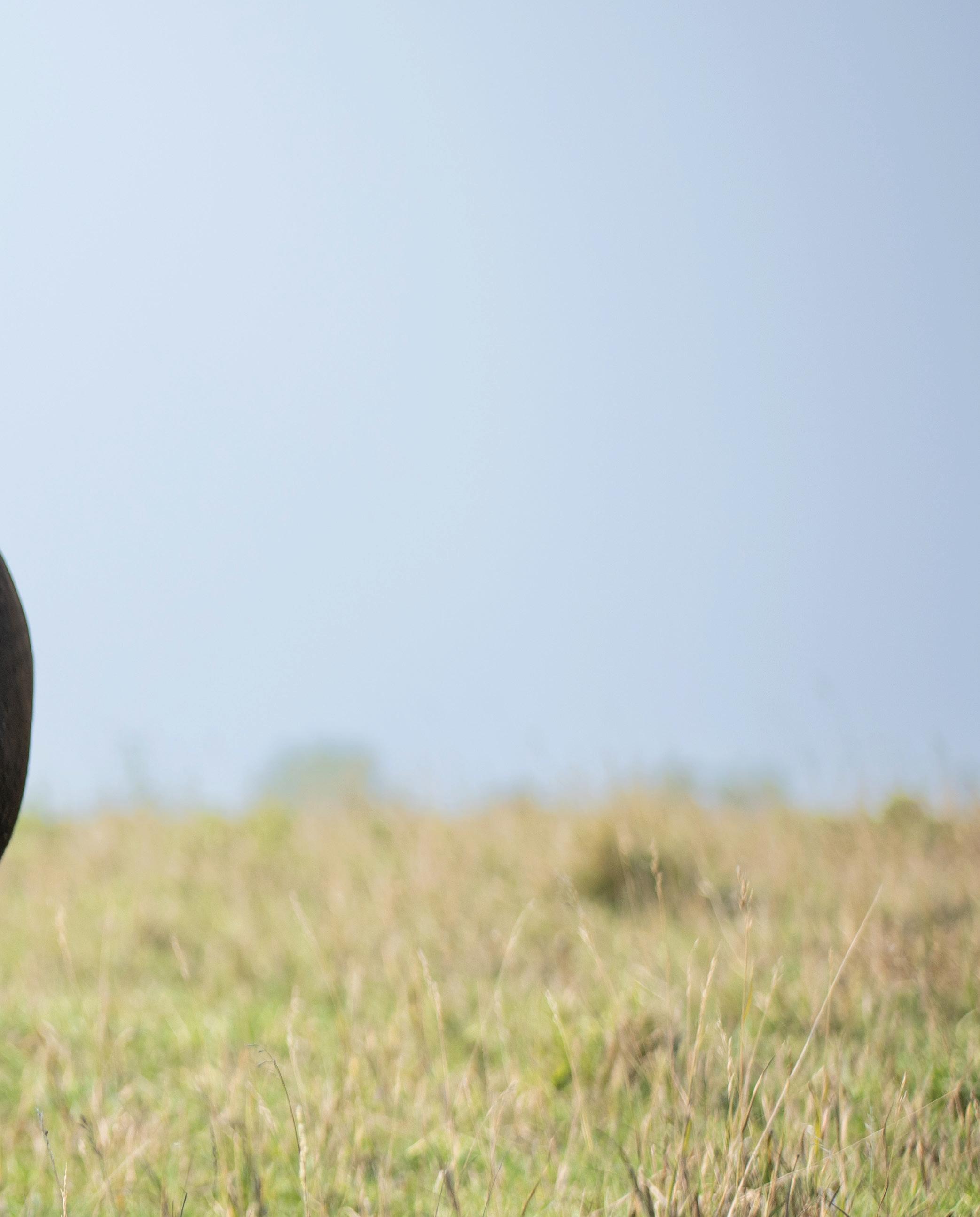
Commercial cattle producers and cattle feeders are turning to Gelbvieh and Balancer® genetics for their superior maternal traits, high performance and excellent carcass merit – commercial cattle producers are turning to Gelbvieh and Balancer genetics because they are delivering profit to their operations.
In this American Rancher recap, we hear from South Dakota commercial producers Scott Hamilton, Jay Anderson and Dallas Burton on the reasons Gelbvieh and Balancer genetics are a fit for their operations.
MATERNAL EXCELLENCE AND HYBRID VIGOR
No breed does maternal excellence quite as well as the Gelbvieh and Balancer breed. Known for the exceptional maternal traits that translate into more productive, profitable cows that stay in the herd longer, the breed elevates the profitability potential for any herd.
Scott Hamilton, operates a diverse farming enterprise in Hitchcock, South Dakota, alongside his brother. Their operation includes a mixed cropping and livestock system, with a focus on beef cattle. Hamilton runs over a thousand head of mother cows, primarily consisting of Balancer genetics. The operation retains all calves and finishes them in their own feedlot, marketing the cattle on the grid program since 2008.
Hamilton places a strong emphasis on marbling in his breeding program to enhance eating quality while also ensuring his cows are well-adapted to the local environment.
“Gelbvieh and Balancer cattle moderated our cow herd size-wise, frame score-wise, and the second thing, they’ve done for us is brought back reproductive efficiency to our herd.
That tells me the productivity is there,” he says.
Gelbvieh and Balancer females make tremendous cows with excellent fertility. They reach puberty early, breed-up and then breed back –arguably the most important aspects of ranching.
Longevity is also a boon for a producer. Gelbvieh and Balancer cows pay for themselves. The longer they remain in the herd, producing a calf every year, the more money they are returning to a rancher’s pocket.
No one wants to keep a snaky cow. The docility of the Gelbvieh and Balancer breed keeps producers coming back for bulls and replacement heifers year after year. Truly a family breed, Bryant, South Dakota rancher Jay Anderson highlights his experience with



FANCY BLACK REPLACEMENT FEMALES
Gelbvieh and Balancer versatility and temperament.
“Disposition is just tremendous in them,” Anderson says. “Gelbvieh and Balancer heifers give you that good mothering of both the Gelbvieh and Angus to fall back on. And then the disposition they have, I just can’t highlight that enough.”
IMPROVED CARCASS MERIT AND MARKETABILITY
In addition to laying the foundation of the herd with incredible maternal attributes, Gelbvieh and Balancer cattle are making a significant impact in the feedlot and on the rail.
In Hitchcock, South Dakota, Dallas Burton is seeing firsthand what Gelbvieh and Balancer genetics are doing for his cow-calf to finish operation. For Burton, the proof is in the numbers.
“Last year was phenomenal,” Burton says. “We hauled out four loads of fat cattle, and on those four loads, the cattle went 97% choice or better. We had barely any selects, no grade fives, very few grade fours, mostly grade twos and threes. We picked up a really good premium on that quality.”
Impressive grading results translate to impressive profitability opportunity for producers who are marketing on a grid.
The data that Gelbvieh and Balancer producers are getting back and ultimately leveraging to make informed decisions about their herds is helping to show the true value of the breed in black and white.
“When we’re grid marketing our fed cattle, we collect individual weights, then we actually track the carcass stat on them, and pull DNA samples. We use all of that data. We database it and use it to benchmark against. I’ll buy bulls accordingly, based off of what that carcass data tells us,” Hamilton says.
Data is a win for both the seedstock and commercial producer and an opportunity to continually improve herd performance and efficiency.
FROM THE PASTURE TO THE FEEDLOT, VERSATILITY MATTERS
Gelbvieh and Balancer cattle offer a unique combination of maternal strength and carcass merit, making
them versatile for various production systems.
“The Gelbvieh and Balancer give us a big advantage. They are good mothering cows, the bulls do well. The cows are deep sided and give us good, heavy calves that we can pull from grass early and will go to feed and winter well,” Anderson says.
The versatility of the breed doesn’t confine producers to one production model, allowing a cow-calf producer to efficiently and profitably retain ownership through the feedlot.
“She can produce a calf, she can graze on ground that isn’t fit for crop production, convert that into meat, then that cow can use the crop residue left after we take the grain off for finishing out our fat cattle and utilize that into something that she can use as energy,” says Burton. “I don’t think there is an animal alive that’s more sustainable than a Gelbvieh momma cow.”



















LRSF Equilibrium M47
Homo Black, Homo Polled 92% Purebred Bull
Sire: LRSF Dynamic J164
Dam:LRSF Jo-Leen K168 ET
One of the best we’ve ever raised. Powerfully constructed with balanced traits led by top 2% MARB in a high percentage purebred and backed by one of our most potent pedigrees.

LRSF Reverence L315 ET
Homo Black, Homo Polled 69% Balancer Bull
Sire: CCRO Carolina Leverage 3214A
Dam: SVVG Rylee U810
One of the most proven, predicable pedigrees you’ll find. U810 was a staple of our donor lineup for years and a full sister to L315 is one of our top donors now.


LRSF Split Rock M160 ET
Homo Black, Homo Polled 73% Balancer Bull
Sire: LRSF Voyageur K182
Dam: LRSF Jo-Leen D92 ET
Big muscled, big topped and big boned with breed leading figures highlighted by top 10% growth, 10% MARB and 10% FPI.

LRSF Arianna L178
Homo Black, Homo Polled 92% Purebred Bred Heifer
Sire: JOB Danell Pay Pal 12H
Dam: DDGR Arianna 77B
Sells safe to DBRG Bold Ruler 3194L, carrying a heifer calf. This is the only opportunity to add Bold Ruler progeny in 2025.



LRSF Aristocrat M100 ET
Homo Polled 94% Purebred Yearling Bull
Sire: LRSF Chevelle J112
Dam: CMR Sunshine 94D
Really hard to poke a hole in. Extremely sound and functional with a ton of power and mass. Will undoubtedly sire very attractive progeny with top end growth.

LRSF Sunshine L167 ET
Homo Polled 75% Balancer Bred Heifer
Sire: GRU Just N Time 714J
Dam: CMR Sunshine 94D
Direct daughter of the $16,000 Sunshine 94D donor with as much power and mass as any you’ll find.


THE CONTINENTAL BREED OF CHOICE GELBVIEH:
FEATURE BY AGA STAFF
Performance. Productivity. Profitability.
Gelbvieh genetics deliver maternal superiority in planned crossbreeding systems. Highly productive cows with adaptability, versatility, and stayability will have a positive impact on not only your bottom line today but the profitability potential of your herd in the future.
Gelbvieh maternal influence is unmatched in a crossbreeding system, offering added fertility, increased longevity and more pounds of calf weaned per cow exposed. And she stays in the herd, offering unsurpassed fertility. The crossbred female is 30% more productive over her lifetime.
To help producers and stakeholders make the most informed decisions possible, AGA publishes EPDs and Indexes. This information puts more information in the hands of those making the breeding and purchasing decisions that will drive herds forward.
We’ve compiled our EPD and Index listings below and look forward to visiting with you about how Gelbvieh and Balancer® genetics can make a difference in your herd, your bottom line and your operation’s future.
MATERNAL TRAITS
Calving Ease Direct (CED): Percent of unassisted births of a bull’s calves when he is used on heifers. A higher number
is favorable, meaning better calving ease. This EPD can be vital to a rancher looking to decrease the amount of calves pulled in his herd.
Milk (Milk): The genetic ability of a sire’s daughters to produce milk expressed in pounds of weaning weight.
Calving Ease Maternal (CEM): Represented as percent of unassisted births in a sire’s first-calving daughters. A higher number represents a more favorable calving ease. This EPD is important to a rancher’s bottom line because it predicts which animals produce daughters with a genetic predisposition to calve unassisted as heifers.
Heifer Pregnancy (HP): Predicts the probability that a bull’s daughters will become pregnant as first-calf heifers in a regular breeding season, expressed as a percent. A higher value on this EPD is favorable, meaning that a higher percentage of a sire’s daughters get pregnant as first calf heifers compared to other sires in his contemporary group.
30-month Pregnancy (PG30): Predicts the probability that a bull’s daughters will become pregnant and calves at three years of age, given that they calved as first-calf heifers. This EPD is expressed as a percent, again, with a higher number being more favorable meaning a higher percentage of a sire’s daughters will calve at three years of age, given they calved as first-calf heifers.
Stayability (STAY): Predicts the genetic difference, in terms of percent probability, that a bull’s daughters will stay productive within a herd to at least six years of age. The stayability EPD is one of the best measures currently available to compare a bull’s ability to produce females with reproductive longevity.
Docility (DOC): Is reported as a percentage, with higher numbers indicating a higher percentage of offspring receiving a disposition score of 1 (docile).
Scrotal Circumference (SC): Predicts the difference, in centimeter, of scrotal circumference of an animal’s male offspring at yearling compared to the SC of other animal’s male offspring.
GROWTH TRAITS
Birth Weight (BW): Predicts the difference, in pounds, for birth weight of the calf.
Weaning Weight (WW): Predicts the difference, in pounds, for weaning weight (adjusted to age of dam and a standard 205 days of age). This is an indicator of growth from birth to weaning.
Yearling Weight (YW): Predicts the expected difference, in pounds, for yearling weight (adjusted to a standard 365 days of age). This is an indicator of growth from birth to yearling.
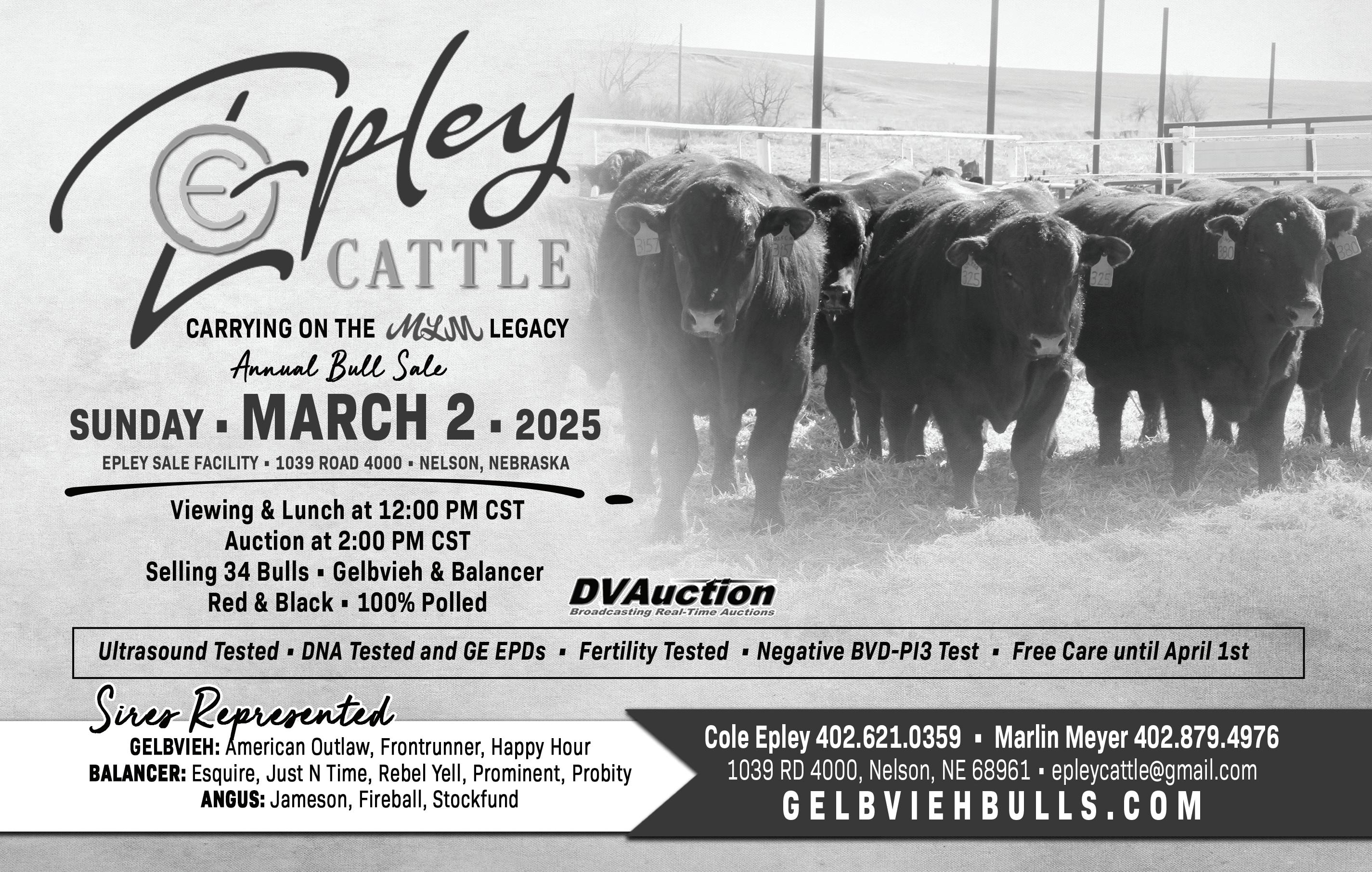


CARCASS TRAITS
Yield Grade (YG): Differences in yield grade score, which is a predictor of percent retail product. Smaller values suggest that progeny will have a better lean to fat ratio.
Carcass Weight (CW): Differences in pounds of hot carcass weight, adjusted to an industry standard age endpoint.
Ribeye Area (CREA): Differences in ribeye area in inches between the 12th and 13th rib. Greater ribeye areas are preferable.
Marbling (MARB): Predicts the differences in the degree of marbling within the ribeye as expressed in marbling score units. Great marbling numbers are preferable and are an indictor of higher carcass quality grades.
Fat (CFAT): Differences for fat thickness, in inches, for a carcass over the 12th rib, smaller numbers of fat thickness are preferable as excess fat can be detrimental to yield grade.
EFFICIENCY TRAITS
Dry Matter Intake (DMI): Represents the average dry matter intake per day consumed in pounds. A negative, or lesser value, is more favorable. For example, Bull A has a DMI EPD of .15 and Bull B has a DMI EPD of -.20, so the progeny of Bull B consumer, on average, .35 pounds less dry matter per day than progeny from Bull A.
*Average Daily Gain (ADG): Difference in average daily gain in pounds based on
an animal’s performance during a feed intake test period.
*Residual Feed Intake (RFI): Defined as the difference between an animal’s actual daily feed intake and its predicted daily intake based on growth rate and body size. Animals with a positive RFI value are deemed more inefficient because they consume more than expected while animals with a negative RFI are considered more efficient because they consume less than expected.
INDEXES
Indexes are tools that allow producers to select for several EPDs at once, making selections more efficient than selecting on one trait at a time. Indexes weight traits based on their importance to a producer’s bottom line by using a trait’s economic and genetic value. Indexes are a good way to put selection emphasis on traits that are economically relevant.
Total Maternal (TM): An index that combines growth and milk information as a prediction of the weaning weight performance of calves from a sire’s daughters. As an index, this value is not reported with an accompanying accuracy. A greater TM value means a mother than returns comparatively higher weaning weights on her calves. TM Index = MK EPD + ½ WW EPD.
$Cow: Represents the genetic value in dollars of profit of an animal when retained as a replacement female relative to other animals in the herd. A higher number represents more profitable genetics for maternal productivity.
$Cow will serve producers in selecting bulls that will sire daughters with stayability and reproductive efficiency as well as other traits that leads to profitability in a production system, such as milk, calving ease, moderate mature weight and the ability of calves to gain. A female’s genetics also influence the performance of her calves in the feedlot and at slaughter, so traits such as feed efficiency and carcass value are also included in $Cow.
Efficiency Profit Index (EPI): An economic selection index developed to aid producers in selecting for more feed efficient cattle that still have acceptable amounts of gain. The EPI provides slight negative pressure on intake, while keeping gain at a constant value. By selecting on this index, producers will be able to find those animals that gain the same amount as the contemporaries while eating less.
Feeder Profit Index (FPI™): An economic selection index designed to aid producers in selecting sires whose progeny will perform in the feedlot and are sold on a grade and yield standpoint. Well ranking sires for FPI have higher marbling and carcass weight than their contemporaries. As a terminal index, little emphasis is put on maternal traits such as stayability and calving ease.

The EPDs with an asterisk (*) next to the name are available to members only.
Cranview Gelbvieh Join us...




RWG Right Combination 5506

&Angus
SATURDAY | MARCH 22, 2025 21st Annual Genetic Progress Sale
Rugby Livestock Auction | Rugby, ND Sale Begins at 1 p.m. | Complimentary Lunch Prior to Sale
We look forward to seeing you in Rugby for our 21st Annual Bull and Female sale! Approximately 45 bulls and 45 females will sell, featuring genetics from:
• LRSF Grand Teton K50 - His offspring look to be easy fleshing and soft made with good muscle expression. We’ll be selling several powerful sons and daughters of this $25,000 Lost River Livestock 2022 sale bull.
• DCSF Post Rock Double Wide 103J1 - This will be our 2nd year to feature calves out of this outstanding sire. Last year’s crop topped our sale.
• MCCA Gunner 947G - Sires calves with exceptional phenotype. Several powerful ET sons sell!
• RWG Right Combination 5506 - Several powerful sons & daughters sell out of this Canadian Grand Champion & NWSS Grand Champion.
• Woodhill Merit H224 - Siring desirable maternal & carcass characteristics, Merit ranks in the top 1% of the Angus breed for marbling. His offspring are scoring extremely high as a group for tenderness. Find them on sale day!
Several of the females are champion show caliber prospects. The entire offering is polled, with many lots being homozygous polled, and every animal will be DNA tested for sire verification.
Don’t miss these outstanding sale features! Please call us to request a sale catalog or visit our website to view the online sale catalog closer to sale day.
CAN’T BE WITH US ON MARCH 22?
Real time bidding is available through DV Auction. Visit DVAuction.com for details.


MCCA Gunner 947G
DCSF POST ROCK Double Wide 103J1
LRSF Grand Teton K50





We would be honored if you would bring your family to meet ours. Cattle available for viewing after 9:00 AM. Ribeyes and beans for lunch. Auction @ 1:30.
SELLING 125 LOTS INCLUDING : 25 Fall Bulls, 55 Spring Yearling Bulls, 20 Open Heifers, 8 Bred Heifers, 17 bred Cows
FEATURING THE INFLUENCE OF THESE GREAT SIRES:
ELLINGSON PROLIFIC
LRSF VOYAGEUR K182
RWG HIGH FIVE 0424
BGGR 9110G “IKE” TOPP STANDOUT 1072 4M BLOCKADE 120
MuscleandFertilitybredintoHighQualityBalancer, Gelbvieh,andAngusHybridCattle!Cattledesignedforthe commercialproducer!



and


Eric & Heather Ehresman 20963 30 th St., Mechanicsville, IA 52306 319-480-1564 • hornsandthorns@netins.net www.loneoakcattleiowa.com












BAG Mr Apothic Red 53M
BAG Mr Easy Rider 7K 108M
BAG Mr Sandman M23
DATA COLLECTION CALENDAR

Collecting data is crucial to the advancement of the beef industry and the improvement of genetic tools for selection decisions. The following calendar was created to simplify the process of data collection while enhancing the accuracy of data submitted to the American Gelbvieh Association (AGA). Below we’ve listed the best time to collect various data points in a calf’s life.

BREEDING CALVING







DATA COLLECTION CALENDAR

For questions on proper data collection or assistance with submitting data to the AGA Online Registry Service, contact the AGA office at 303-465-2333.
WEANING YEARLING

Calf Weaning Weight

Dam Mature
Cow Weight

Calf Weaning Temperament

Collect Calf DNA Samples (TSU, Hair or Blood)

Dam Body Condition Score


Yearling Weight

Dam Foot & Leg Score

Hip Height


Yearling Temperament

Scrotal Circumference on Bulls

Foot & Leg Score

Pelvice Measurements on Females
Ultrasound Data: Ribeye Area, Percent Intramuscular Fat (%IMF), Fat

CATTLE NUTRITION:
THE KEY TO PROFITABLE RANCHING
FEATURE BY LAURA HANDKE
This article recaps the first webinar in the three-part University of Nebraska webinar series “Fundamentals of Feeding the Cow”.
For U.S. cattle ranchers, mastering cow nutrition is crucial for maximizing profitability and productivity. And one often overlooked yet incredibly impactful management tool is body condition scoring (BCS).
NUTRITIONAL FUNDAMENTALS
Effective cow feeding goes beyond simply providing feed; it’s about meeting specific nutritional requirements that fluctuate throughout the year.
High nutritional demand occurs during lactation and just before calving. It is important to consider periods of high and low nutritional demands, as well as potential stress periods that can result in nutritional deficiencies. “We need to think about that beef cow and beef heifer’s nutritional requirements.
We need to think about their gestating requirements, their lactating requirements, their growing requirements…,” says Troy Walz, University of Nebraska – Lincoln Beef Extension Specialist.
PROTEIN REQUIREMENTS
Cows have dual protein needs: one for themselves and another for their rumen microbes. The National Research Council transitioned from a crude protein system to a metabolizable protein system in 1996, recognizing that not all proteins are equal.
“The crude protein system assumes that all protein is equal. It assumes that the protein in alfalfa hay is equal to the protein in prairie hay is equal to the
protein in cane hay and distiller grains. That truly is not the case,” Walz explains.
The metabolizable protein system considers both rumen degraded protein (RDP) and rumen undegraded protein (RUP). RDP is used by microorganisms in the rumen, while RUP bypasses the rumen and is absorbed in the small intestines for growth, gestation, lactation, and maintenance.
BODY CONDITION SCORING: A FREE MANAGEMENT TOOL
BCS is a cost-free method to evaluate a cow’s energy reserves in the form of fat.
The BCS system ranges from 1 (very skinny) to 9 (obese), with ideal scores being 5 for mature cows and 6 for firstcalf heifers at calving. Key areas to assess include the brisket, ribs, back, hooks and pins, and tail head.
Walz recommends conducting BCS assessments regularly. “Anytime you’re looking at your cows, you should be giving them a body condition score because it will tell you if those cows are gaining weight, maintaining or losing weight,” he says.
Body condition significantly affects a cow’s reproductive performance and her calf’s health. Cows with a BCS of 5 or 6 at calving typically exhibit heat by 55 days post-calving, maintaining a 365day calving interval.
Walz discussed a 15-year study on how supplementing cows in the last trimester affects their offspring.
“Cows that received two pounds of supplement that last trimester, 79% of them calved in the first 21 days of that heat cycle. That’s 21 more days of weight you’re going to be able to put
on that calf, and at current prices, that’s significant.”
Cows that fail to meet their nutritional requirements are subject to “weaker” colostrum. Poor colostrum quality is expressed in calf performance and the inability of a calf to meet their genetic potential – both of which rob profitability opportunity.
“Calves with inadequate colostrum have 6.4x greater risk of sickness in the first 28 days of life, 3.2x greater risk of sickness prior to weaning, and 3x greater risk of being sick in the feedlot,” Walz told attendees.
Research from the U.S. Meat Animal Research Center (USMARC) shows that calves with inadequate colostrum also face a 5.4x greater risk of pre-weaning death, and sickness in the first 28 days of life was associated with a 35-pound lower expected weaning weight.
The post-weaning period offers the best opportunity for BCS assessment and improvement for cows. This 60-day window allows producers to efficiently increase BCS before calving, setting the stage for next year’s production success.
“Right after weaning is the time to put weight on a cow. If my mature cow is a four at weaning, I would strive to try to put some weight on her before calving,” Walz says.
“Your ranch is your greatest resource. Two people could have the exact same ranch, but the way you manage makes all the difference”. By understanding and applying these fundamental principles of cow nutrition, you can optimize your herd’s health, productivity, and profitability throughout the year.
EVENTS OF INTEREST
FEBRUARY 2025
FEB. 3 Taubenheim Gelbvieh 35th Annual Production Sale, Amherst, Neb.
FEB. 6 Black Hills Stock Show Gelbvieh & Balancer Show and Sale, Rapid City, S.D.
FEB. 8 Prairie Hills Gelbvieh Annual Bull Sale, Gladstone, N.D.
FEB. 8 Genetic Power Bull and Female Sale, Springfield, Mo.
FEB. 11 2025 Draft Picks Bull Sale, Red Deer County, AB, Canada
FEB. 14 Lemke Cattle Annual Bull & Female Sale, Lawrence, Neb.
FEB. 15 Locust Hill Cattle Company 4th Annual Bull & Female Sale, Pelham, N.C.
FEB. 15 Overmiller Gelbvieh & Red Angus Production Sale, Smith Center, Kan.
FEB. 20 Gustin’s Diamond D Gelbvieh 2025 Production Sale, Medina, N.D.
FEB. 22 Black Gold Genetics 19th Annual “Share the Gold” Bull Sale, Pritchett, Colo.
FEB. 22 Seedstock Plus North Missouri Bull Sale, Kingsville, Mo.
FEB. 22 Post Rock Cattle Co. Cowman’s Kind Bull & Female Sale, Barnard, Kan.
FEB. 22 Larson’s Lost River Livestock 15th Annual Production Sale, Clearbrook, Minn.
FEB. 23 Geidel Cattle Co. Bull Sale, Creston, Iowa
FEB. 26 Grund Beef Genetics Annual Bull Sale, Sharon Springs, Kan.
FEB. 27 Plateau Gelbvieh Annual Bull Sale, Brush, Colo.
FEB. 28 34th Annual Pot of Gold Sale, Montrose, Colo.
MARCH 2025
MARCH 1 Judd Ranch 47th Gelbvieh, Balancer and Red Angus Bull Sale, Pomona, Kan.
MARCH 1 Lazy TV Ranch 44th Annual Production Sale, Selby, S.D.
MARCH 1
Seedstock Plus Arkansas Bull Sale, Hope, Ark.
MARCH 1 Flying H Genetics Bull Sale, Arapahoe, Neb.
MARCH 1 Kentucky Beef Expo Gelbvieh/ Balancer Sale, Frankfort, Ky.
MARCH 2 Epley Cattle “Carrying on the MLM Legacy” Annual Bull Sale, Nelson, Neb.
MARCH 3 Hojer Ranch 33rd Annual Gelbvieh & Balancer Production Sale, Lake Preston, S.D.
MARCH 4
Swanson Cattle Company Annual Production Sale, Oxford, Neb.
MARCH 5 Warner Beef Genetics Genetic Investment Bull Sale, Arapahoe, Neb.
MARCH 7 Davidson Gelbvieh & Lonesome Dove Ranch 36th Annual Bull Sale, Ponteix, Sask., Canada
MARCH 8 Bluegrass Gelbvieh Alliance Production Sale, Fredonia, Ky.
MARCH 8 Rippe Gelbvieh & Rippe Angus Bull Sale, Fairbury, Neb.
MARCH 8 Seedstock Plus Red Reward Bull & Female Sale, Osceola, Mo.
MARCH 8 Hilltop Farms Annual Gelbvieh/ Balancer Bull & Female Sale, Carthage, Mo.
MARCH 11 Bar Arrow Catte Company 35th Annual Production Sale, Phillipsburg, Kan.
MARCH 13 Raile Cattle Co. Annual Production Sale, St. Francis, Kan.
MARCH 15 Lone Oak Cattle 13th Annual Bull Sale, Mechanicsville, Iowa
MARCH 21 Southwest Iowa Gelbvieh & Balancer Bull and Female Sale, Creston, Iowa
MARCH 22 Cranview Gelbvieh 21st Annual Genetic Progress Sale, Rugby, N.D.
MARCH 22 Seedstock Plus South Missouri Bull & Female Sale, Carthage, Mo.
MARCH 27 Kicking Horse Ranch Annual Production Sale, Oilmont, Mont.
MARCH 29 Wilkinson Gelbvieh Ranch Bull Sale, Model, Colo.
APRIL 2025
APRIL 5 Circle S Ranch 18th Annual “Going to Grass” Production Sale, Canton, Kan.
APRIL 12 2025 Knoll Crest Farm Spring Bull & Female Sale
APRIL 26 Heart of America Gelbvieh Association Showcase and Elite Heifer Futurity Sale
JUNE 2025
JUNE 23-27 Grand Ole Gelbvieh Junior Classic, Lebanon, Tenn.
OCTOBER 2025
OCT. 24 T Bar S Cattle Co. Focused on the Future Bull Sale, Billings, Mo.
DECEMBER 2025
DEC. 5 2025 Knoll Crest Farm Total Performance Bull Sale
Visit the online version of Upcoming Events at Gelbvieh.org for additional dates of upcoming sales and more information on each event.
Editor’s Note:
If you have a sale or event information for this listing, please email the information to malerie@gelbvieh.org. This includes tours, expos, field days and other Gelbvieh events.
EVENTS OF INTEREST
BREEDERS CORNER















& Nancy Holste 3113 260th Street Clarinda, Iowa 51632 712-303-0263 • 712-303-1947 tripleh1@unitedwb.coop





Stuart Jarvis 26 E. Limestone Rd. • Phillipsburg, Kan. 67661 e-mail: bararrow@ruraltel.net • 785-543-8120



Purebred A.I. Seedstock Bulls and Heifers Available. Al & Mary Knapp Cell: (913) 219-6613 18291 158th Street H: (913) 724-4105 Basehor, Kan. 66007 www.triplekgelbvieh.com e-mail: knappa@swbell.net

MINNESOTA




MISSOURI
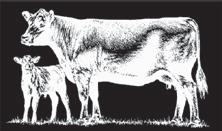
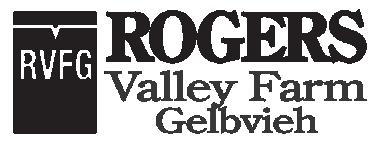





BREEDERS CORNER












































Rob Arnold

6700 County Rd. 19 S. Minot, N.D. 58701 (701) 624-2051 (H) (701) 720-8823 (C)
Email: RLAGelbvieh@aol.com
Registered Gelbvieh & Balancers®

Dennis & Sherry Gustin Family
Al and Peggy Gustin Mandan, N.D. • 701-663-7266
Richie & Sarah Heinrich 701-320-6484 (cell) email: gustindd@wildblue.net www.gustinsdiamondd.com


OKLAHOMA


VIRGINIA











treaty
BREEDERS CORNER SERVICE














Contact Malerie for advertising opportunities in The Profit Picture and Gelbvieh World publications.
MALERIE MARKLEY GELBVIEH MEDIA PRODUCTIONS COORDINATOR
malerie@gelbvieh.org | 303-465-2333
3 G Ranch 70
B/F Cattle Co. .............................. 63, 71
Bar Arrow Cattle Company .............. 71
Bar JR Gelbvieh ........................... 20, 72
Bar T Bar Ranches............................ 70
Black Gold Genetics ......................... 45
Bluegrass Gelbvieh Alliance ............ 31
Bow K Ranch ............................... 53, 70
Bull Barn Genetics ...................... 59, 74
C.H. Morris & Sons, LLC. ................... 73
Canadian Gelbvieh Association ....... 74
Cattlemen’s Connection............... 1, 74
Cave Creek Cattle............................. 73
C-Cross Cattle Company ................. 72
Cedar Top Ranch ........................ 72, BC
Chimney Butte Ranch...................... 73
Circle S Ranch 25, 71
CJ&L Livestock 73
Clinch Mountain Gelbvieh 73
Cranview Gelbvieh 61, 73
Dan McCarty, Auctioneer 74
Danell Diamond Six Ranch 72
Davidson Gelbvieh & Lonesome Dove Ranch 43
Doak Lambert, Auctioneer 74
Dobson Ranch 62
Draft Picks Bull Sale ......................... 35
Ertel Cattle ......................................... 51
Flying H Genetics ........................ 34, 72
Gale Rippey Farms ............................ 74
Geidel Cattle Co. ............................... 59
Grand Valley Gelbvieh/Balancer .... 20
Green Hills Gelbvieh ......................... 72
GS Ridge Top Ranch ......................... 20
Gustin’s Diamond D Gelbvieh .... 55, 73
Hart Farm Gelbvieh .......................... 70
Heart of American Gelbvieh Association...................................................... 50
High Bar Cattle Company ................. 21
Hilltop Farms ................................ 16, 71
Hodges Ranch ................................... 70
Hojer Ranch ............................20, 11, 73
Ivers Cattle Company ....................... 71
J & K Gelbvieh Farm, Inc. ................. 70
Judd Ranch ........................................ 40
Kentucky Beef Expo 37
Kicking Horse Ranch 20, 27, 72
Knoll Crest Farm 73
Koehn Cattle Co. 73
Larson’s Lost River Livestock 57, 71
Lazy TV Ranch 7, 73
Ledgerwood Gelbvieh 74
Lemke Cattle 38
Little Windy Hill Farms 73
LiveAg 29
Lone Oak Cattle .......................... 62, 70
Martens Gelbvieh ................ 20, 56, 70
Martin Cattle Company ............. 20, 70
Mitchell Marketing Services ............ 74
MLM Gelbvieh ....................... 20, 59, 72
Mulroy Farms, LLC ............................ 70
Nine Bar Nine Gelbvieh ..................... 74
Nowack Cattle Company .......... 36, 71
Overmiller Gelbvieh ........................... 16
Plateau Gelbvieh .................. 20, 62, 70
Plus One Cattle Co. ........................... 70
Post Rock Cattle Company ........ 12, 71
Pot of Gold Sale ................................ 20
Prairie Breeze Ranch .................. 15, 71
Prairie Hills Gelbvieh .................... 5, 73
ProHart Seedstock ........................... 70
Rafter R Gelbvieh ............................. 70
Raile Cattle Co. .................................. 37
Red Ridge Gelbvieh ........................... 71
Rippe Gelbvieh 20, 46
Rogers Valley Farm Gelbvieh 71
Rumfelt Gelbvieh 71
S.J. Cattle Co 73
Sawtooth Gelbvieh Cattle & Hay 72
Seedstock Plus 17
Southwest Iowa Bull Sale 33
Squeakin’ By LK Farms 27, 72
Swanson Cattle Co 23
Swenson Gelbvieh ...................... 20, 71
T Bar S Cattle Co. .........................71, 76
Taubenheim Gelbvieh ...................... 72
The 88 Ranch .................................... 72
Thull Gelbvieh Farm ......................... 73
TJB Gelbvieh ......................................IFC
Triple K Gelbvieh ................................ 71
Volek Ranch ...................................... 73
Warner Beef Genetics .................... IBC
Wilkinson Gelbvieh ..................... 56, 70
Witt Cattle .......................................... 71
Wolf Gelbvieh .................................... 72
ADVERTISING INDEX












































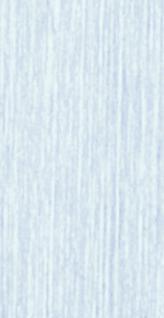





















































































































































TUESDAY, FEB.18, 2025

175 2-YEAR-OLD BULLS SELL
175 RANGE-DEVELOPED 2 -YEAR-OLD BULLS
BULLS ARE INDIVIDUALLY FEED EFFICIENCY TESTED, GRASS GRAIN TESTED AND GENOMICALLY TESTED TUESDAY, FEBRUARY 18 12:30 PM | BURWELL, NE
BALANCER & ANGUS
FEATURING: 50 ET BULLS

cedartopranch@yahoo.com
